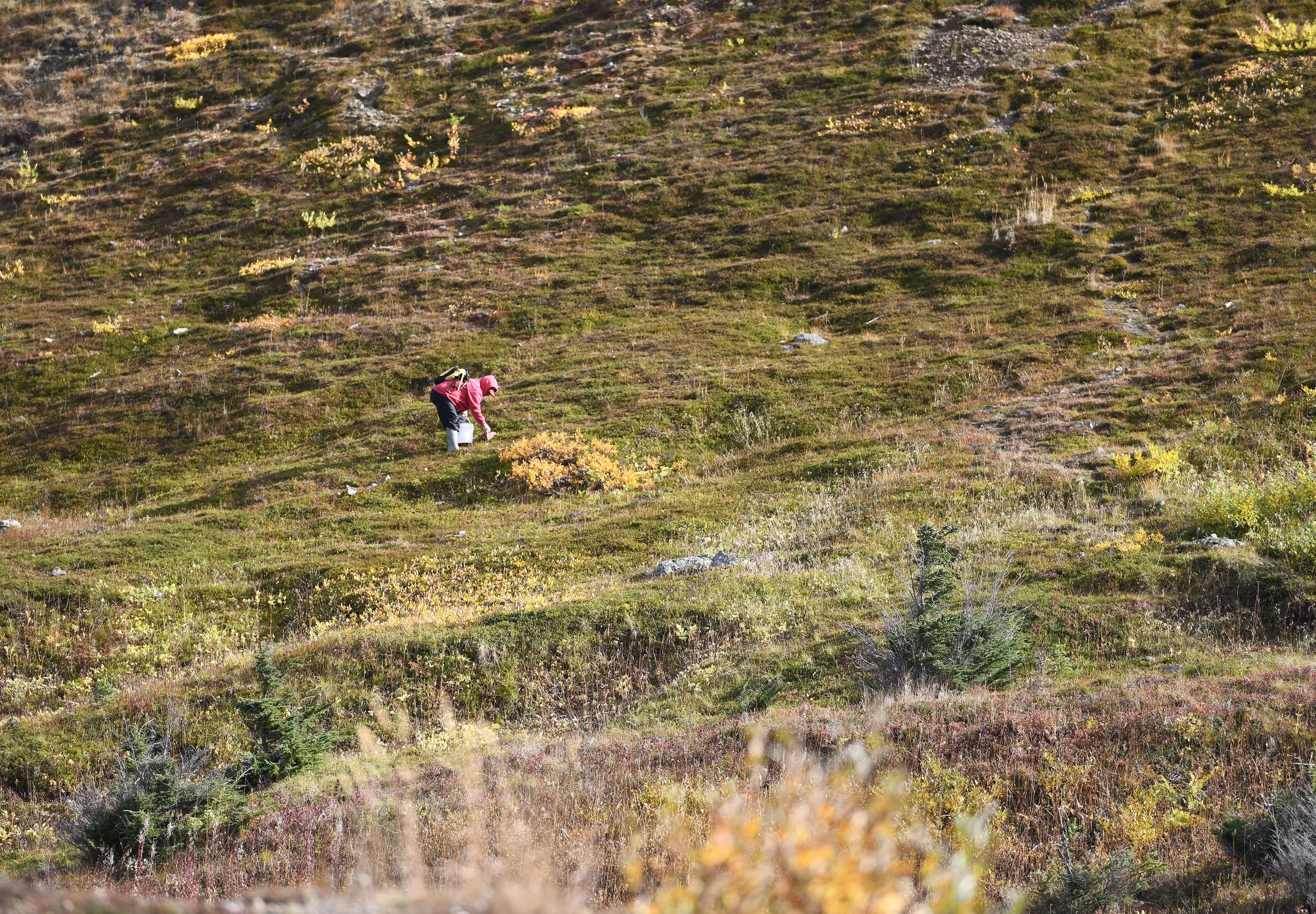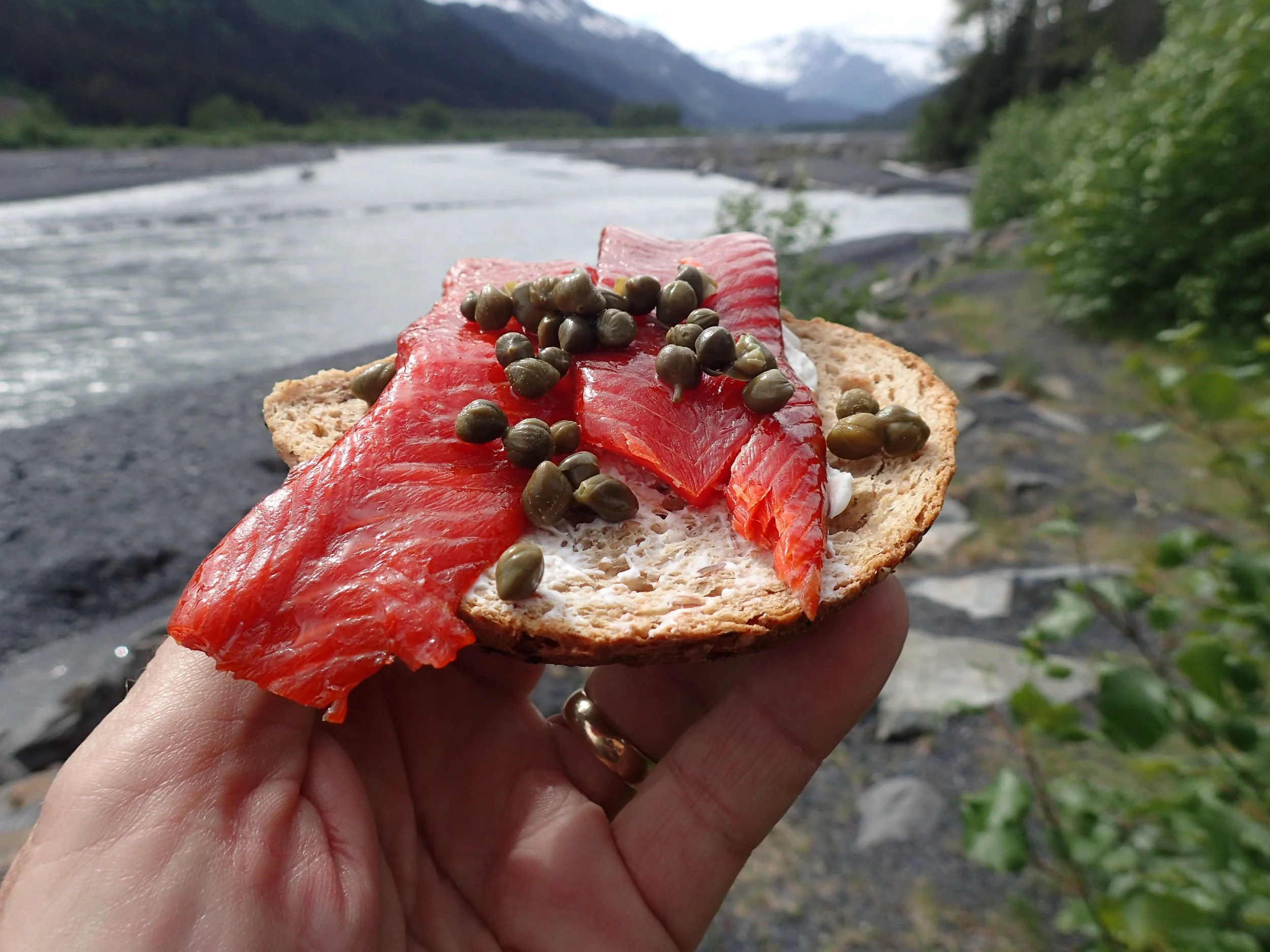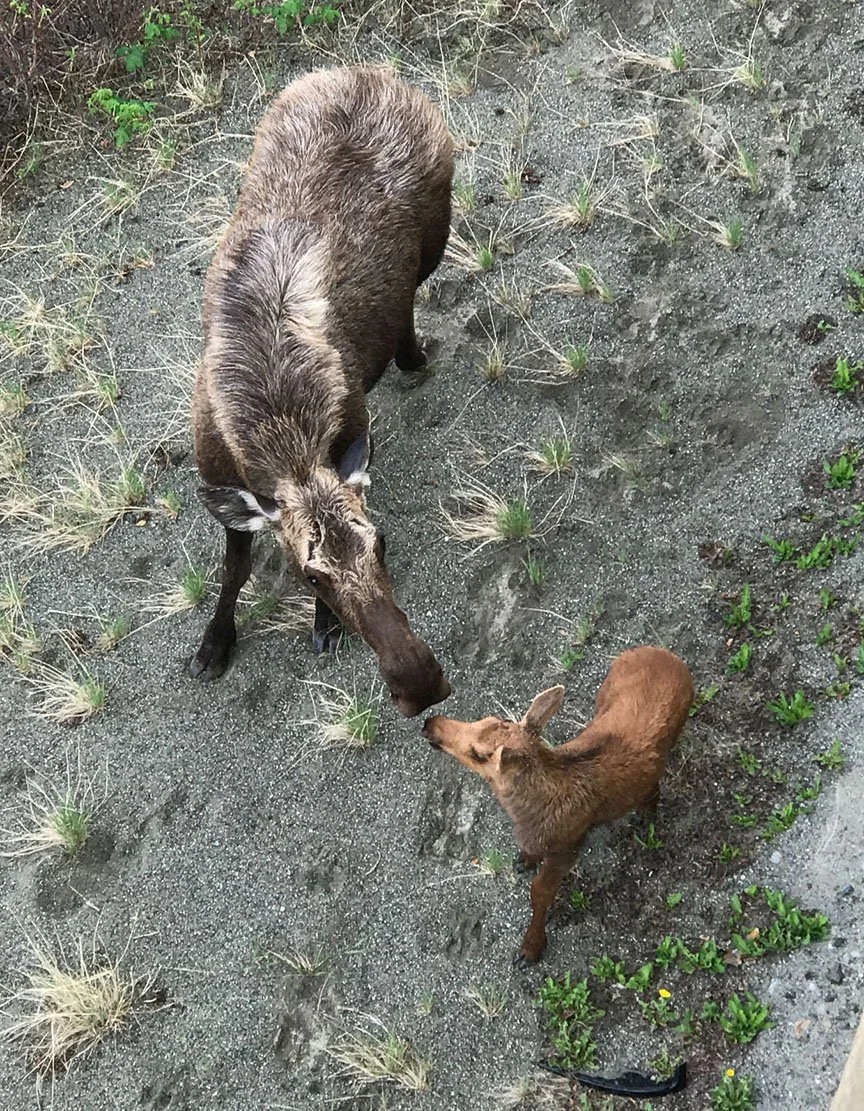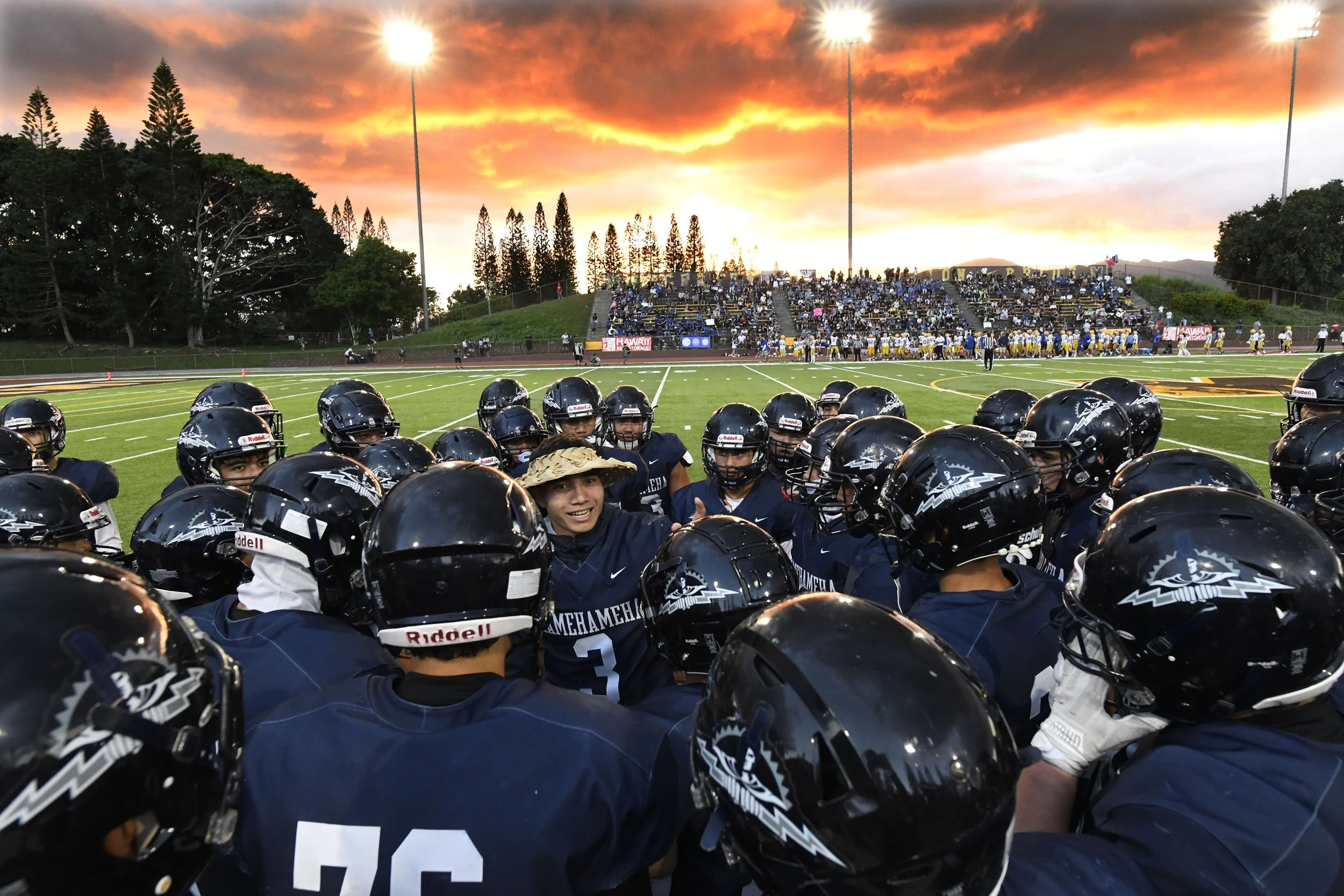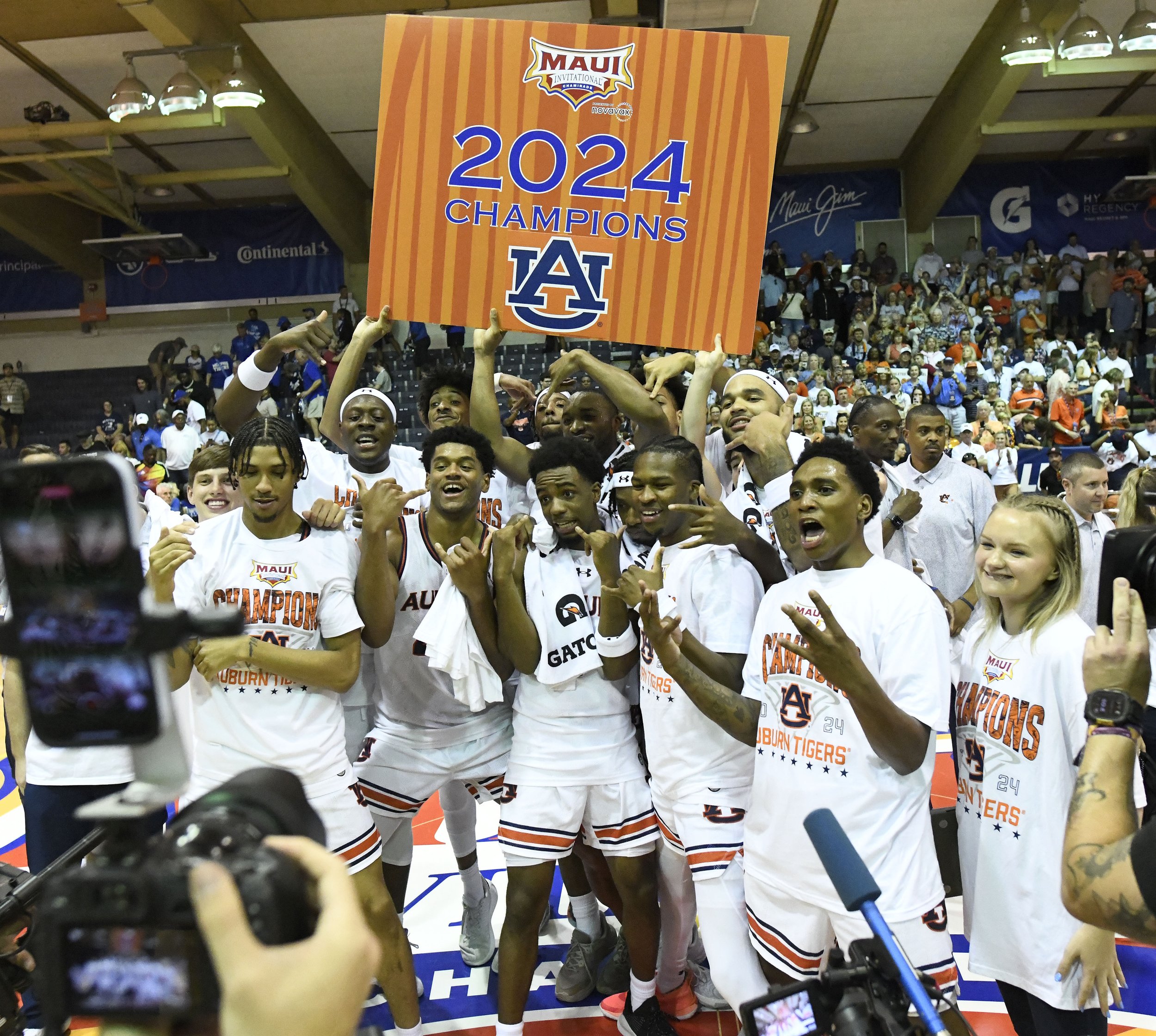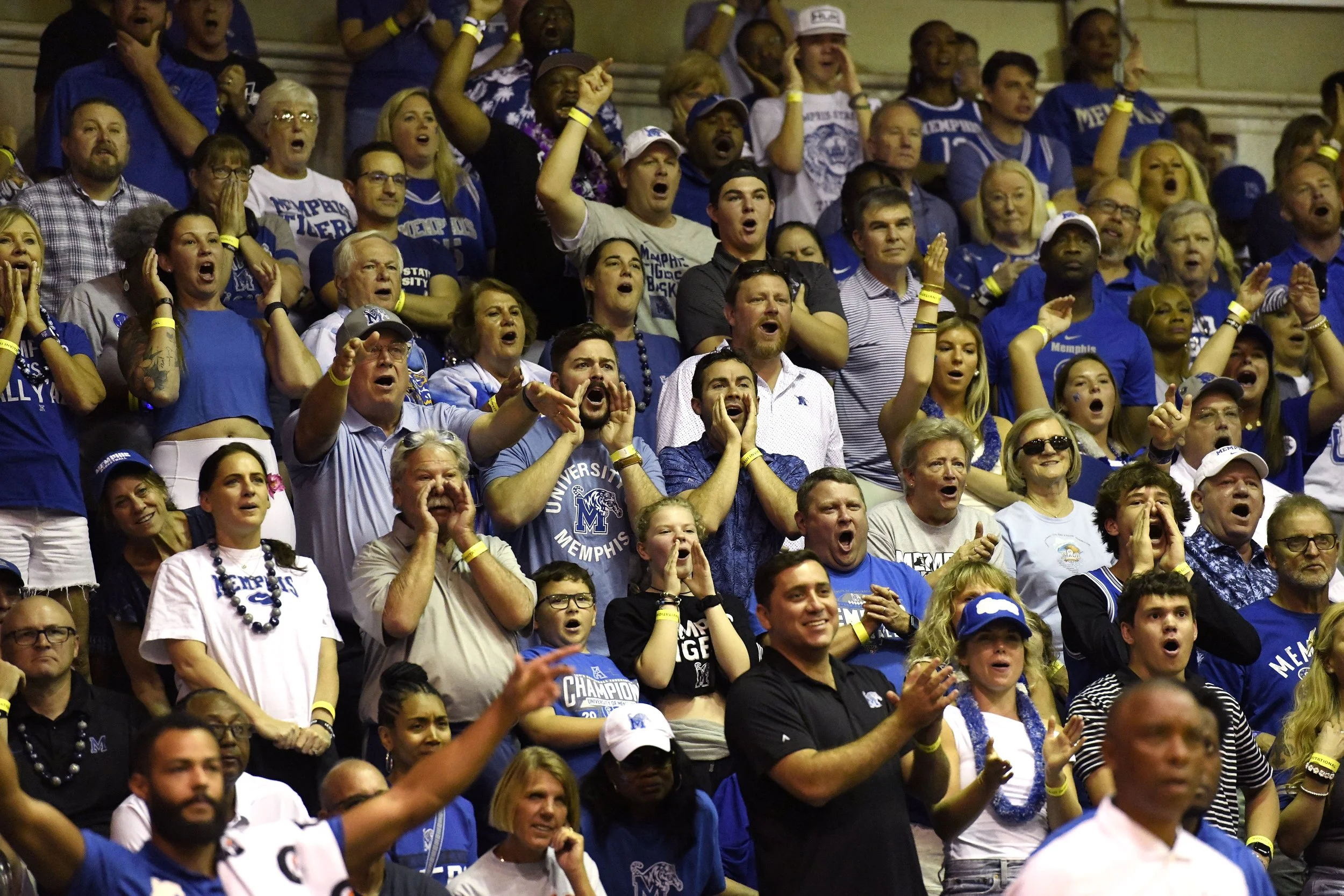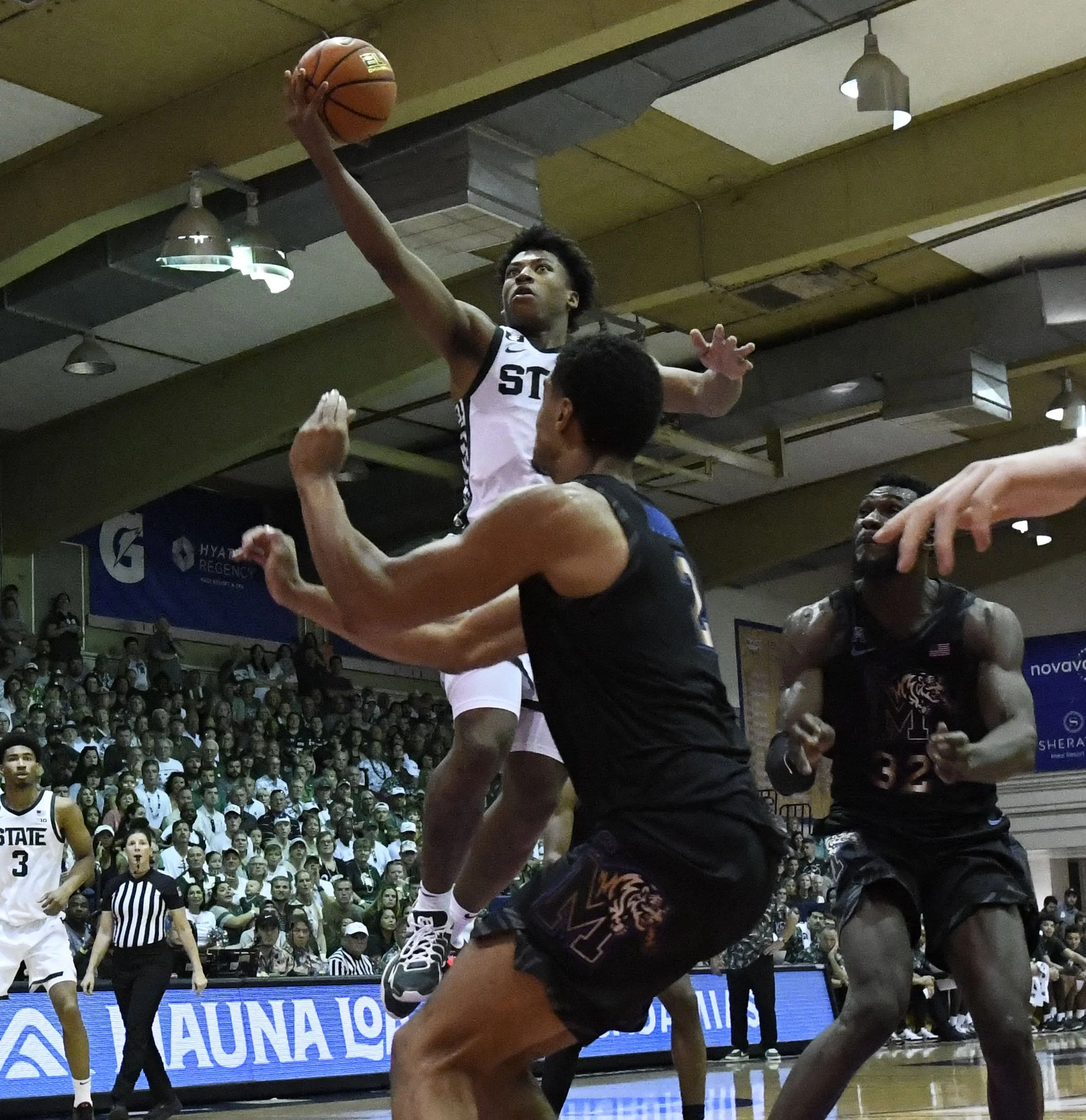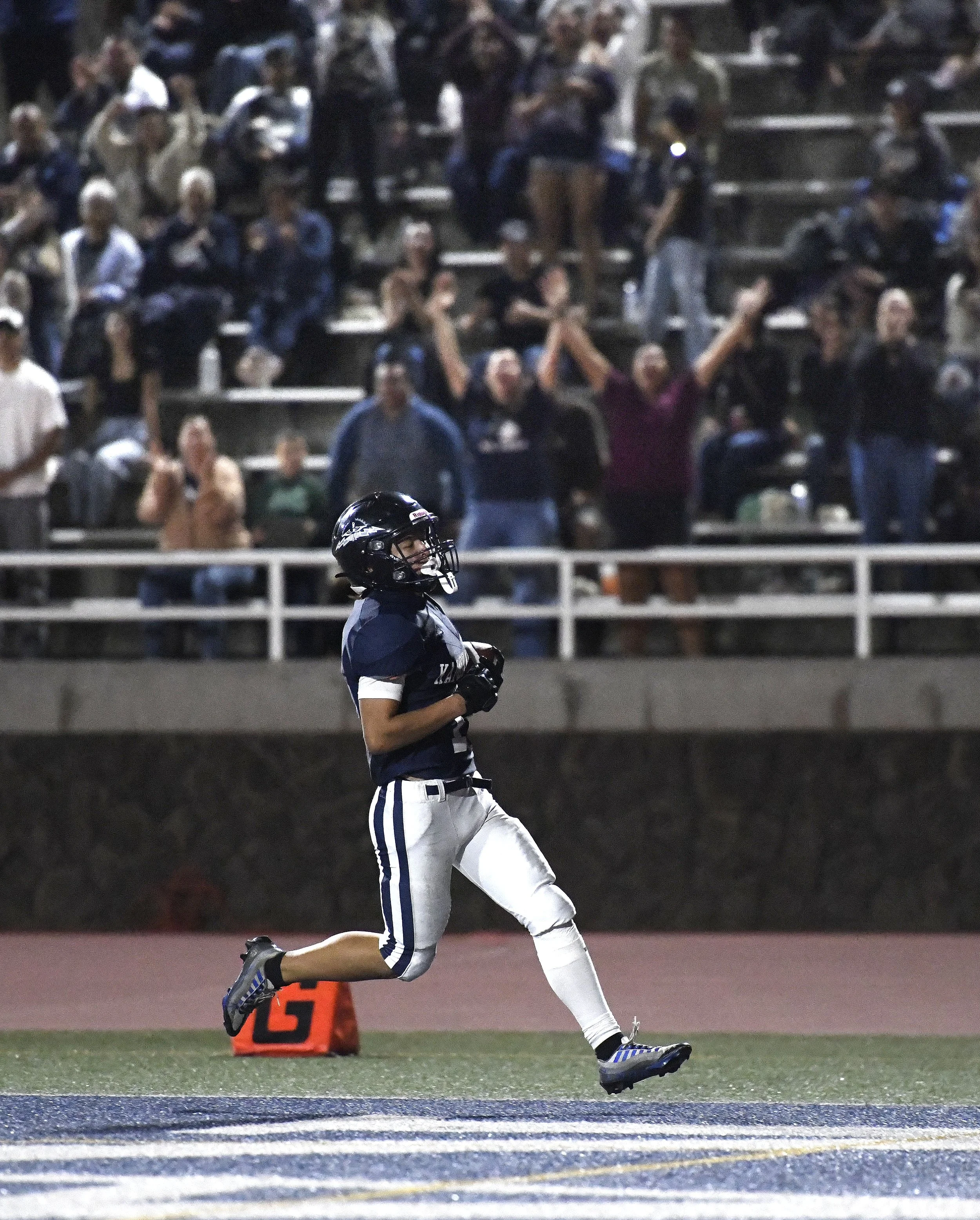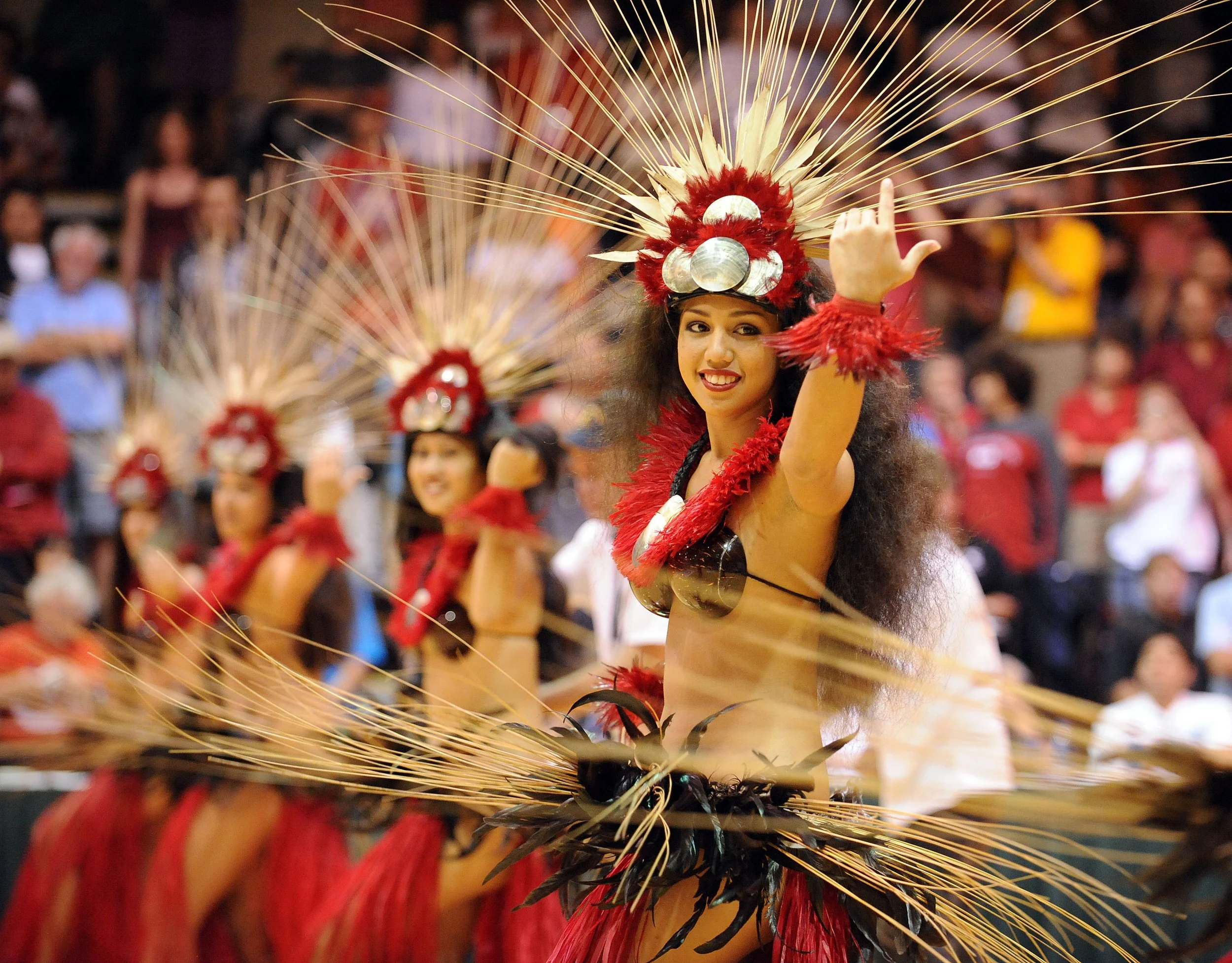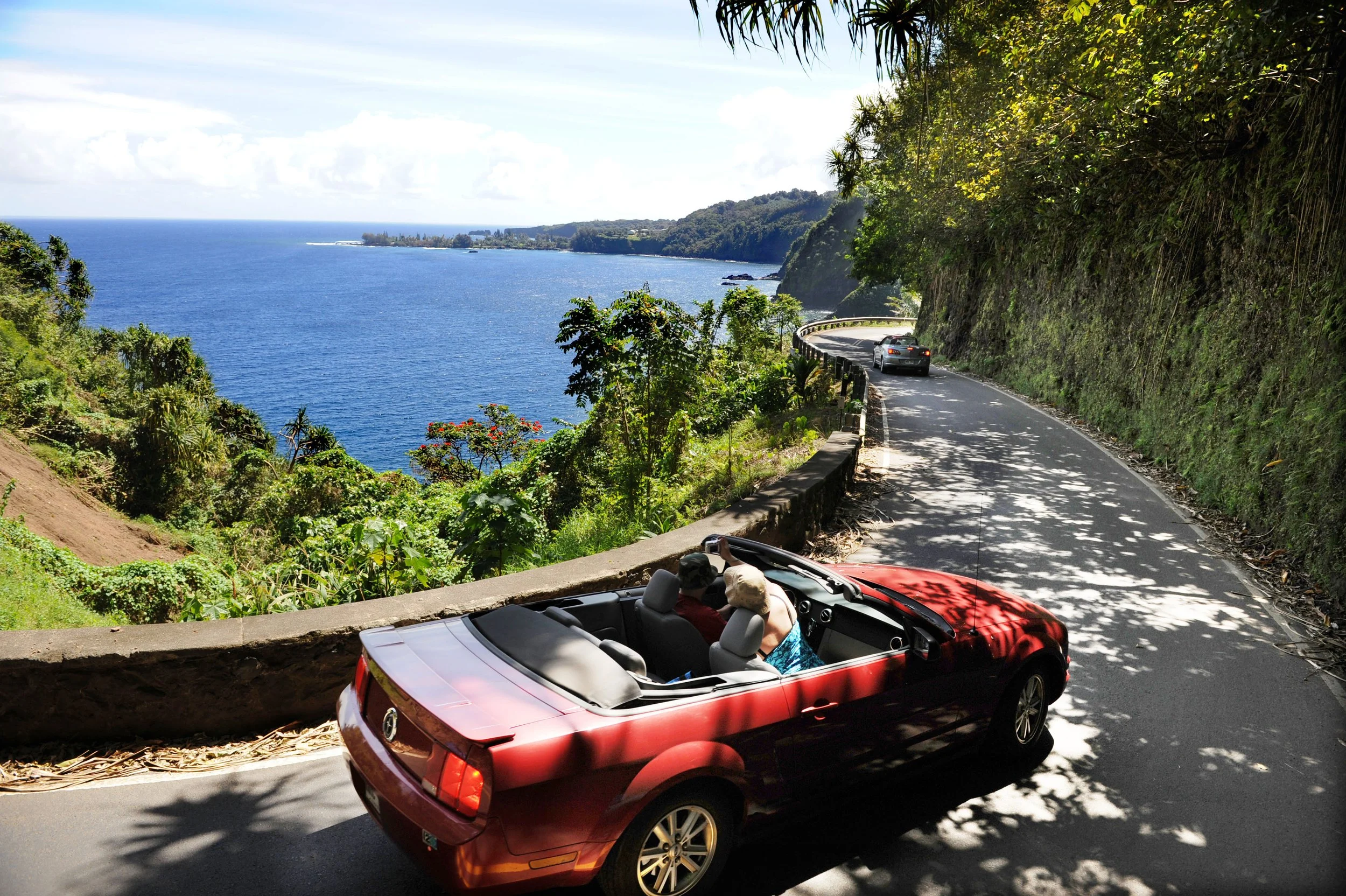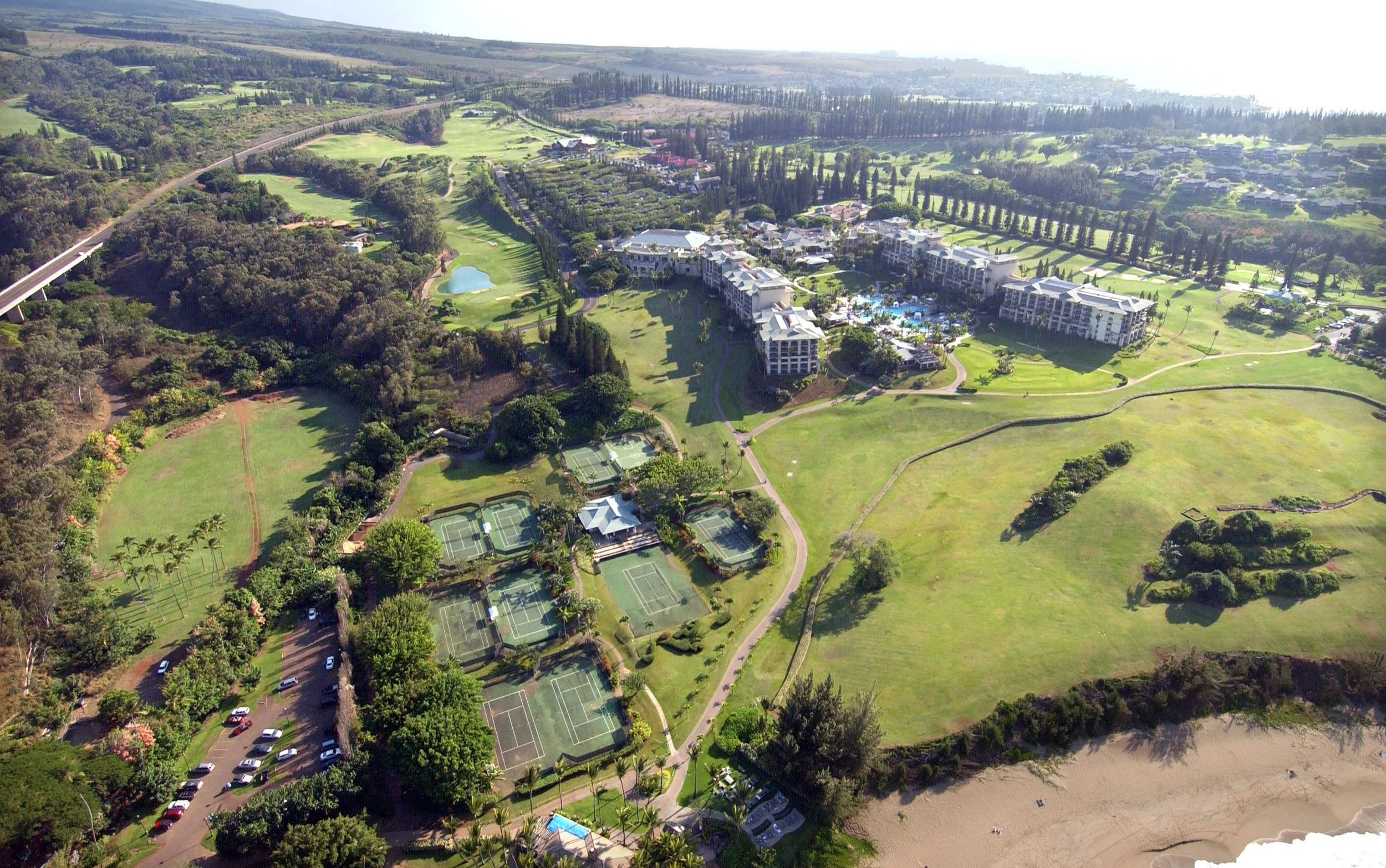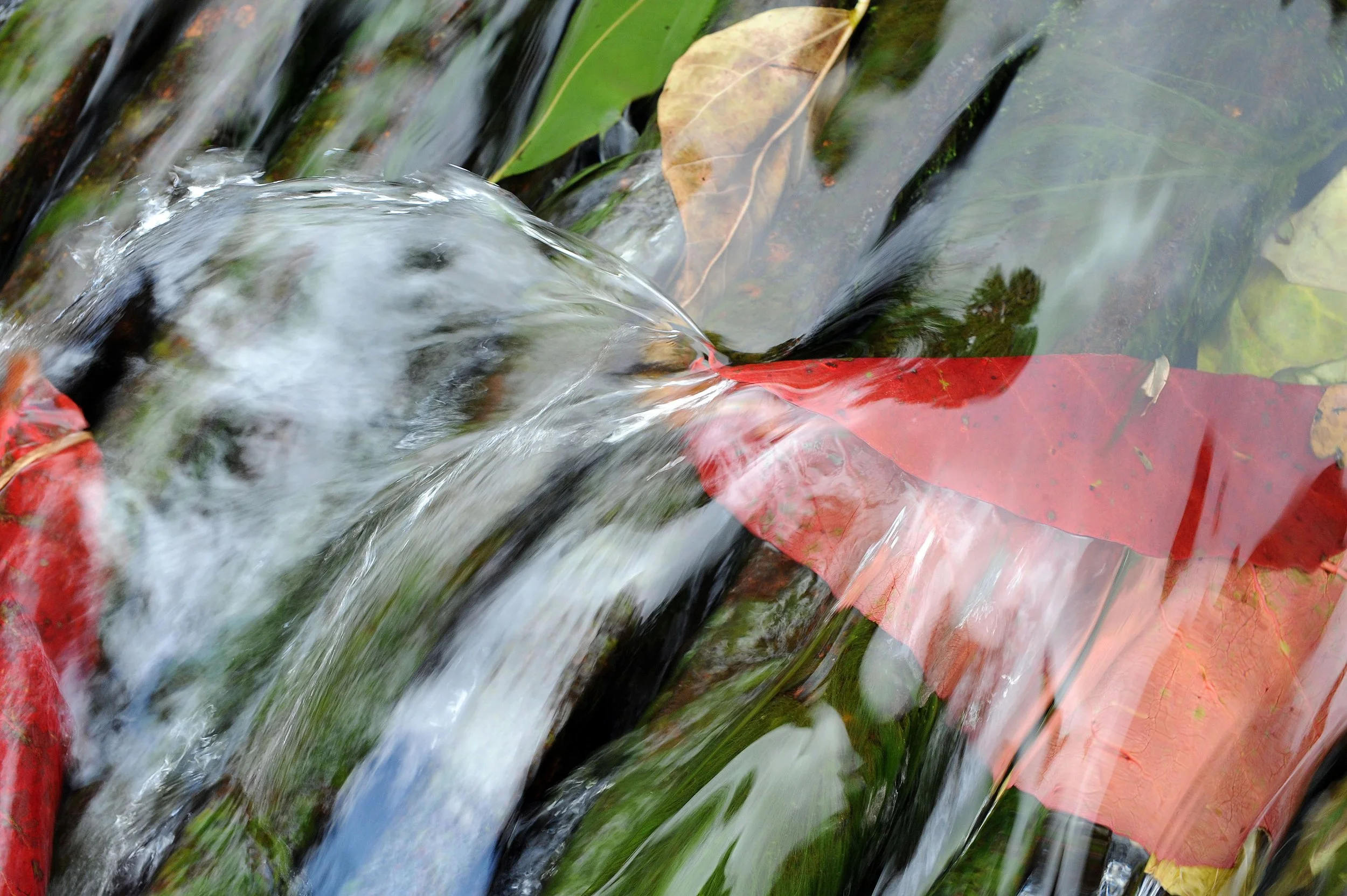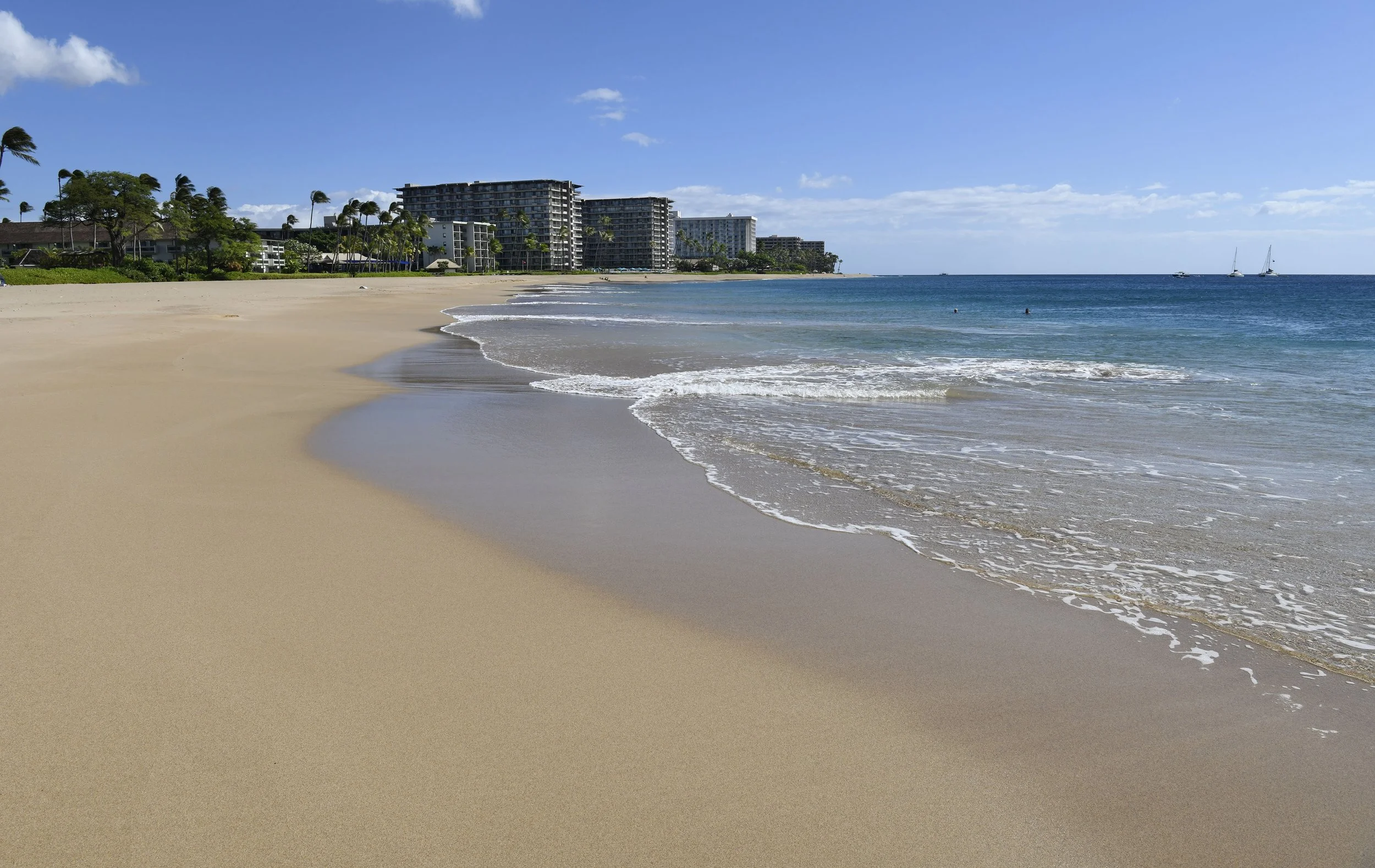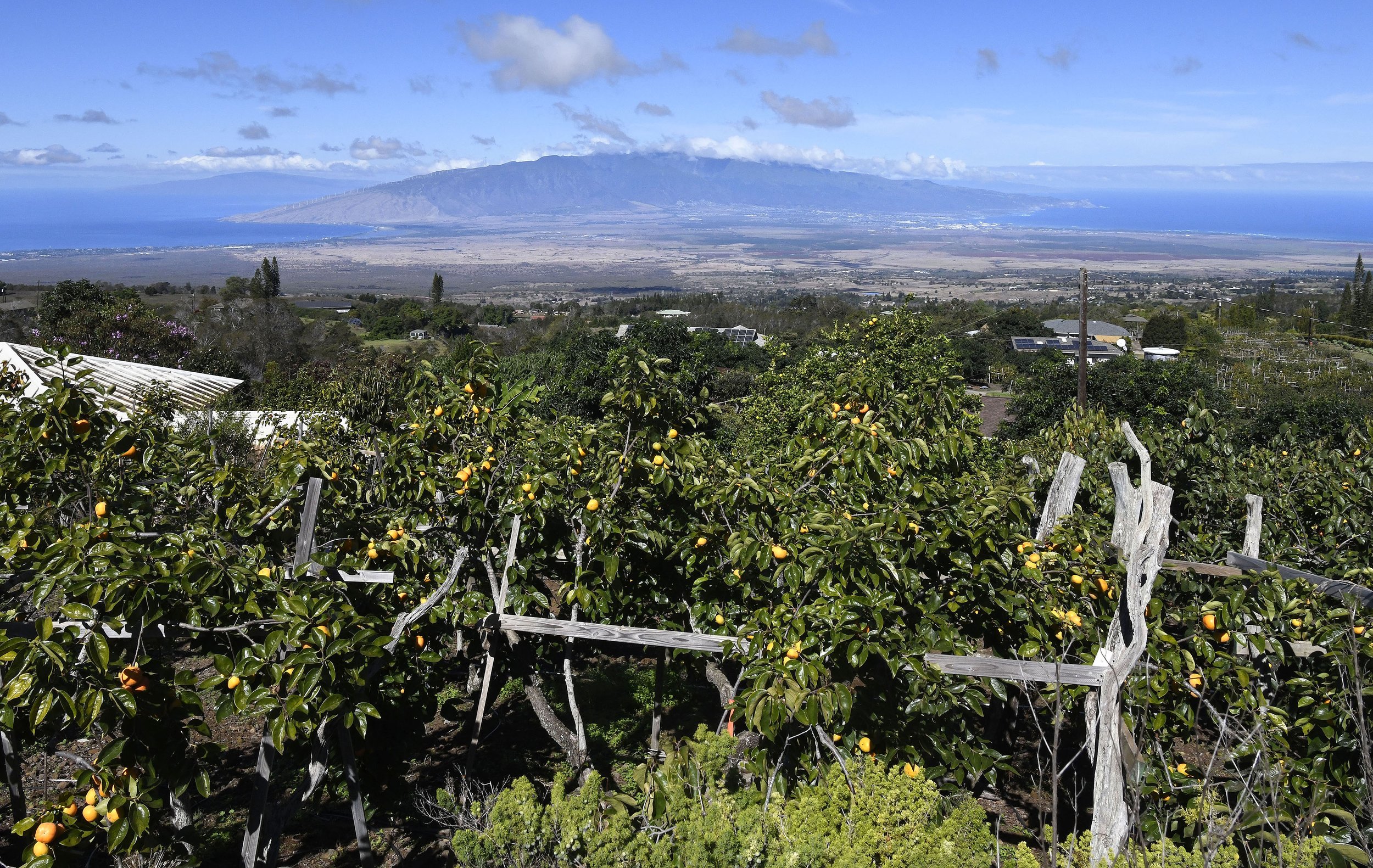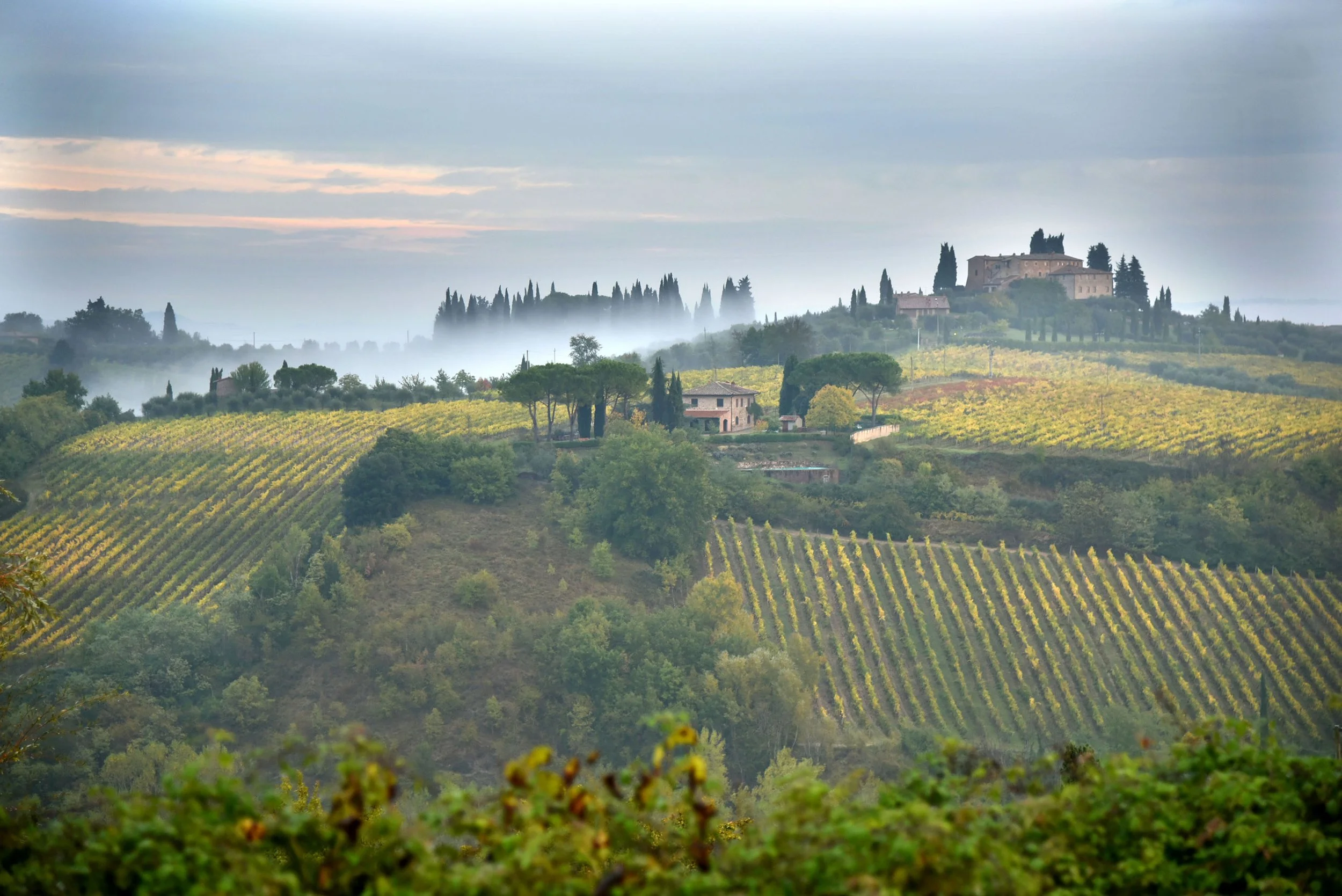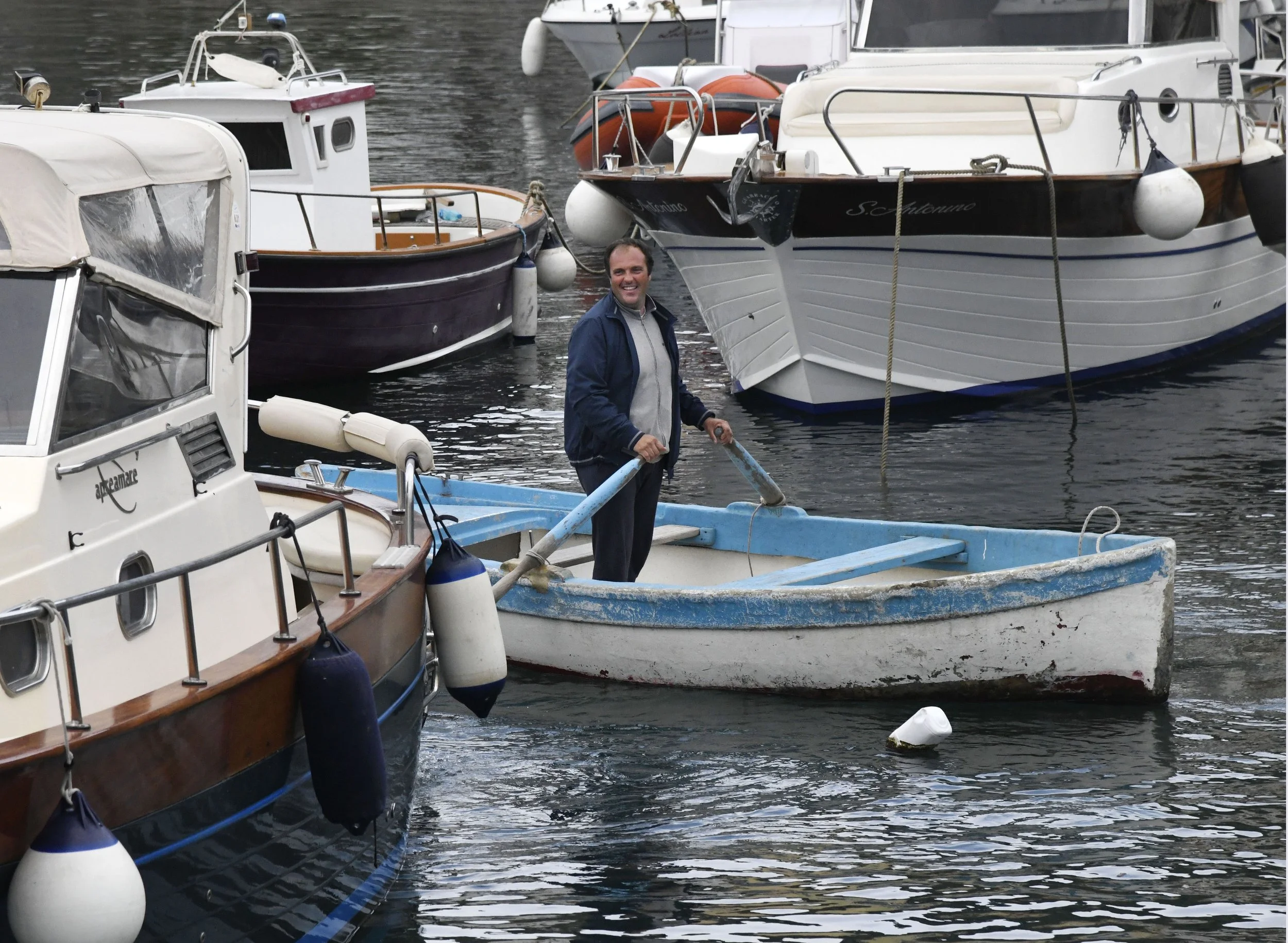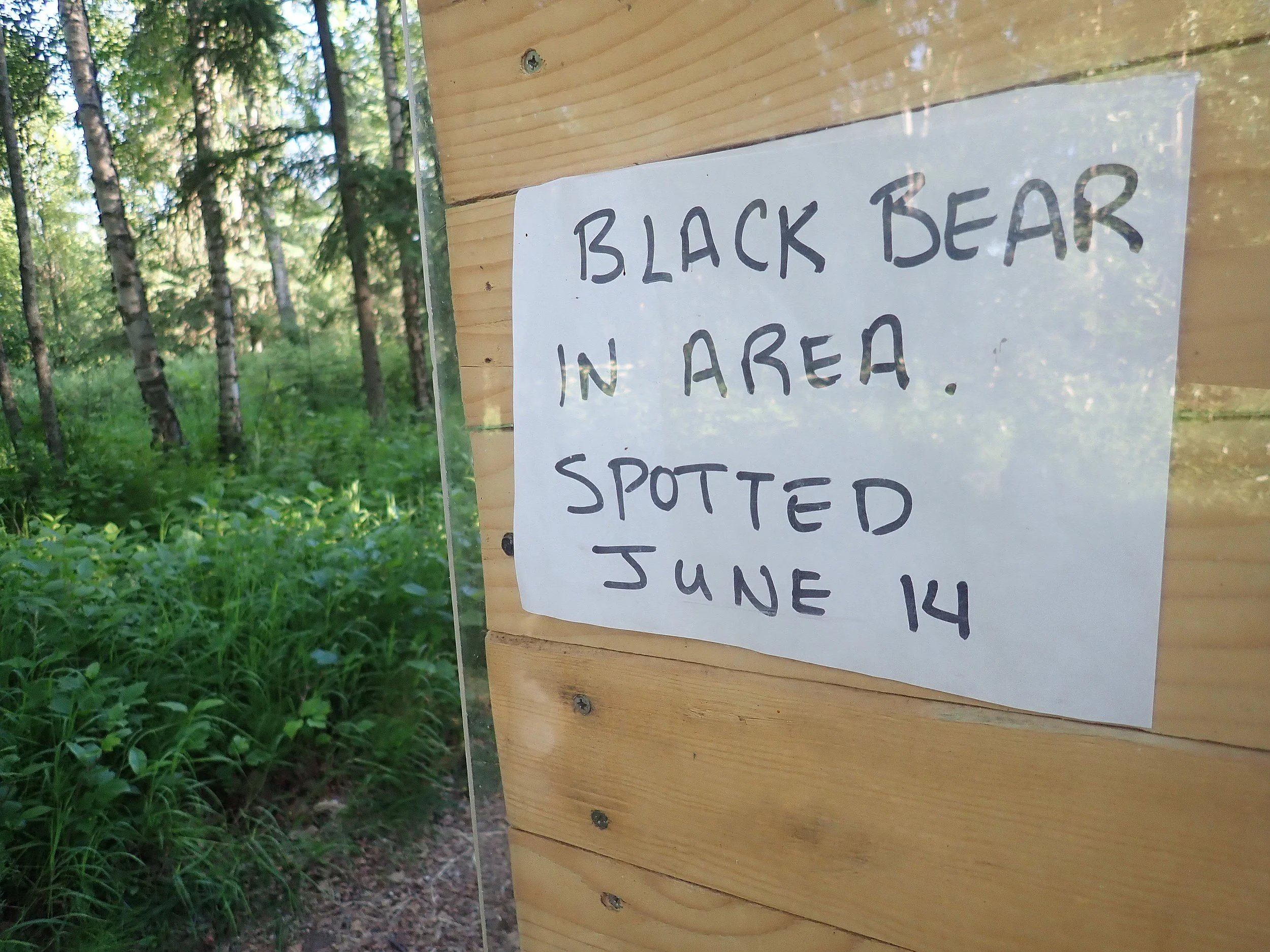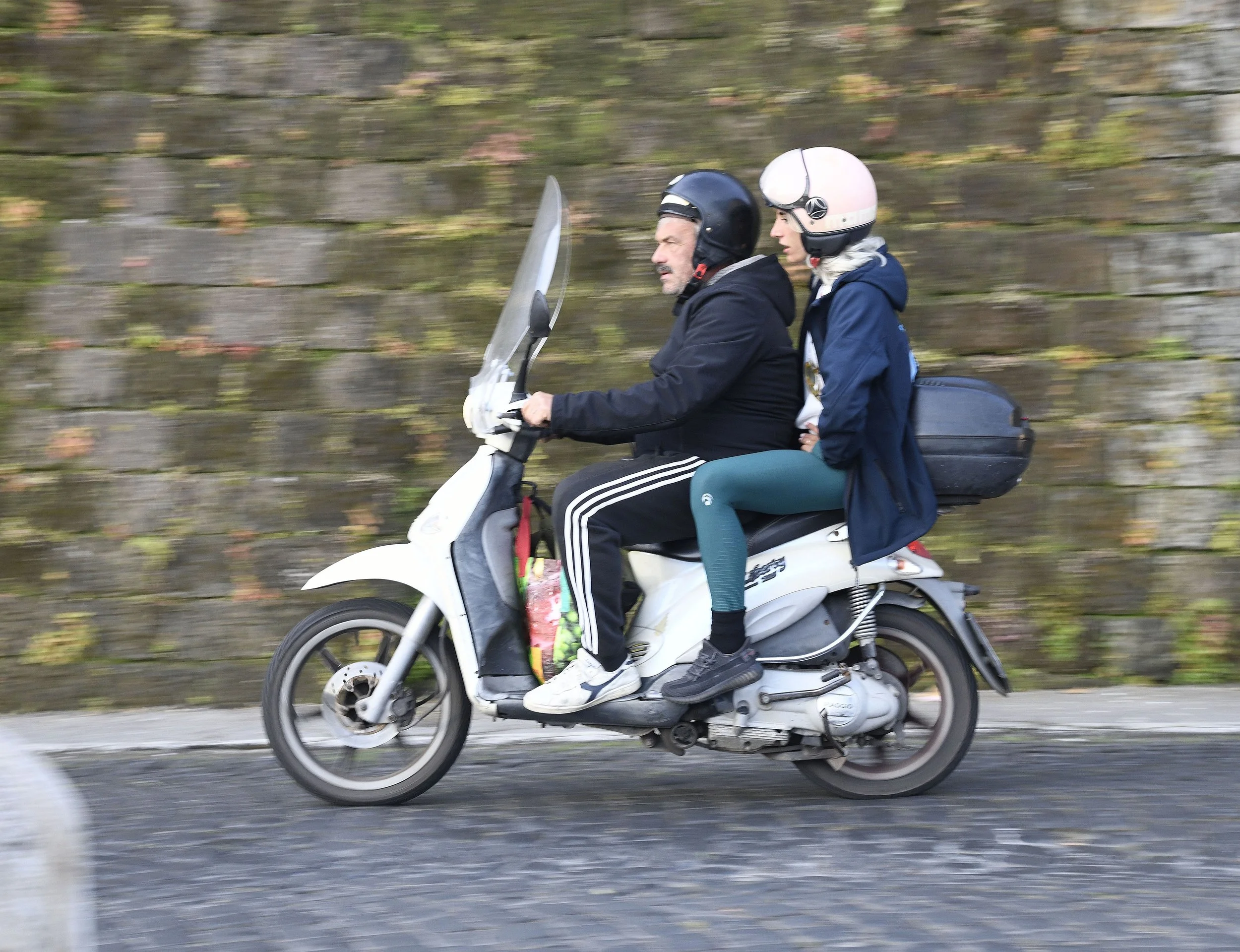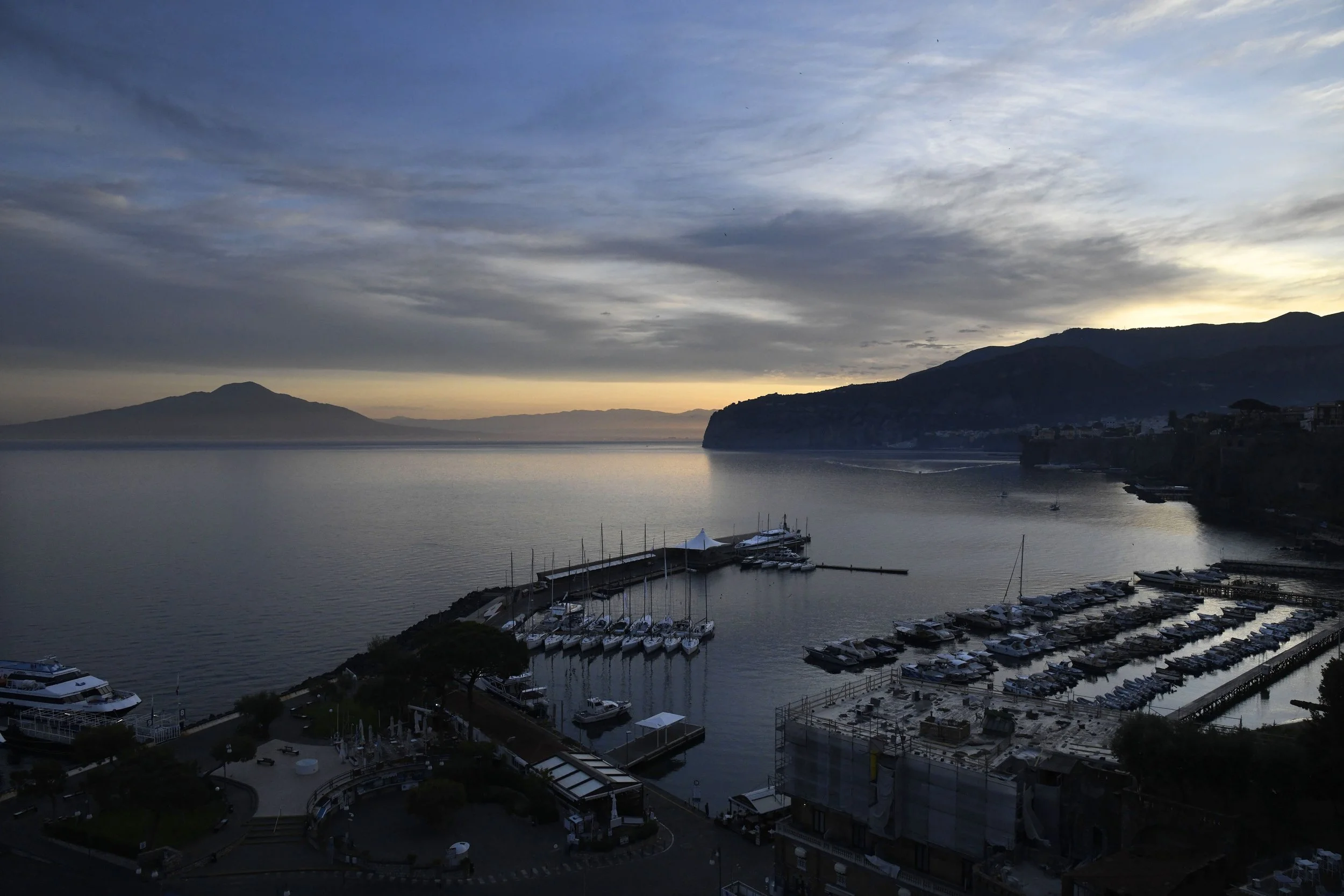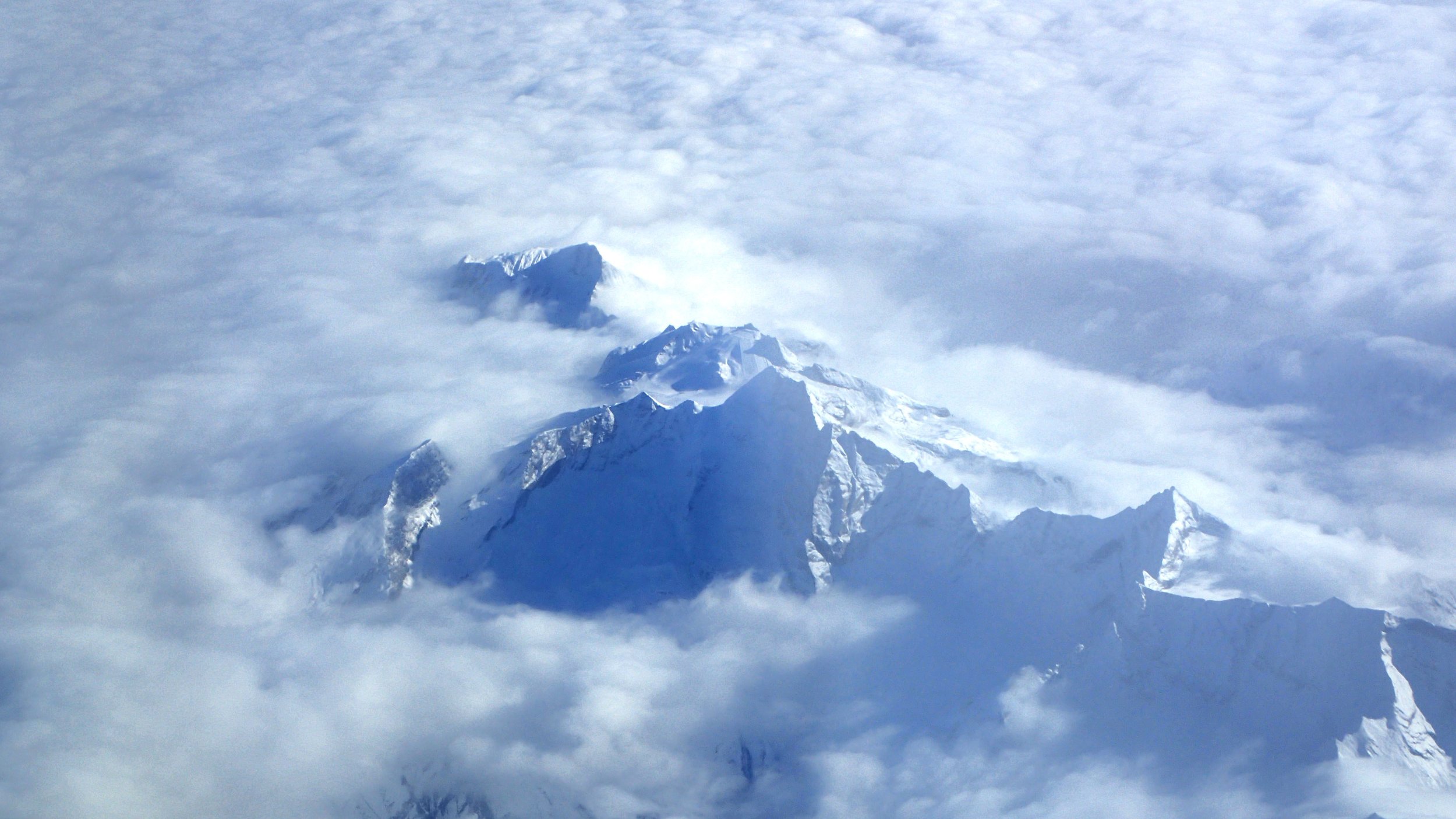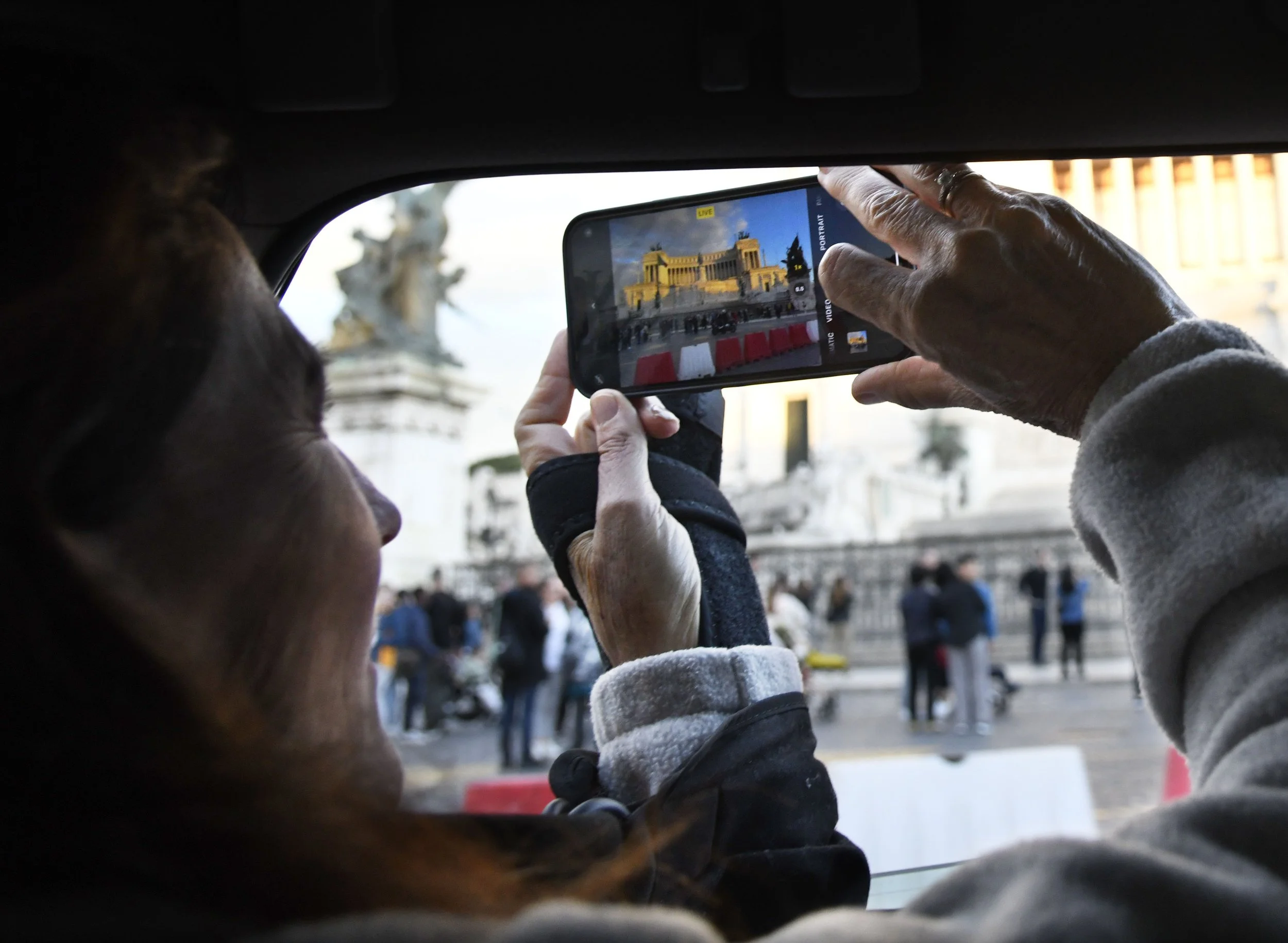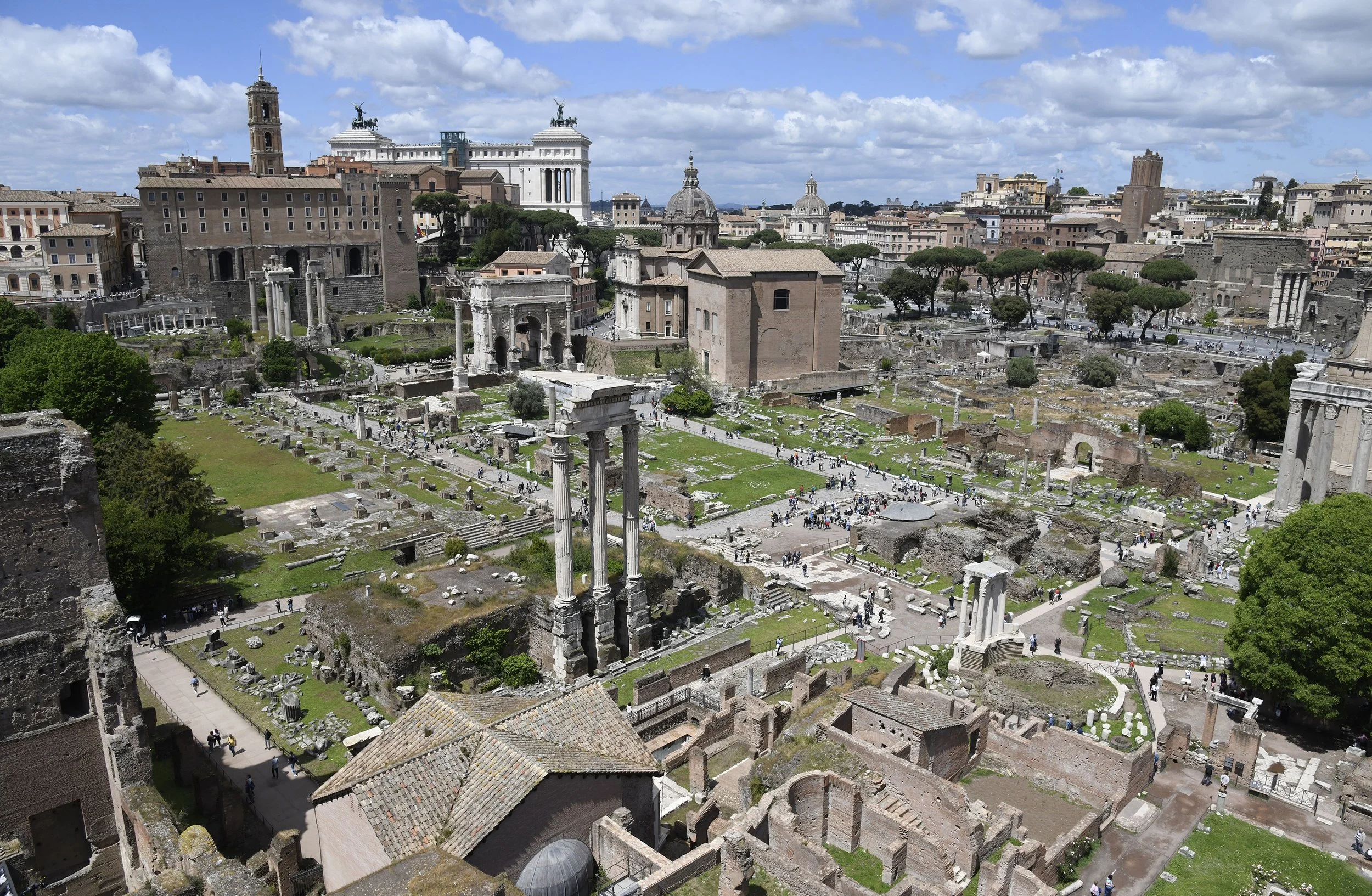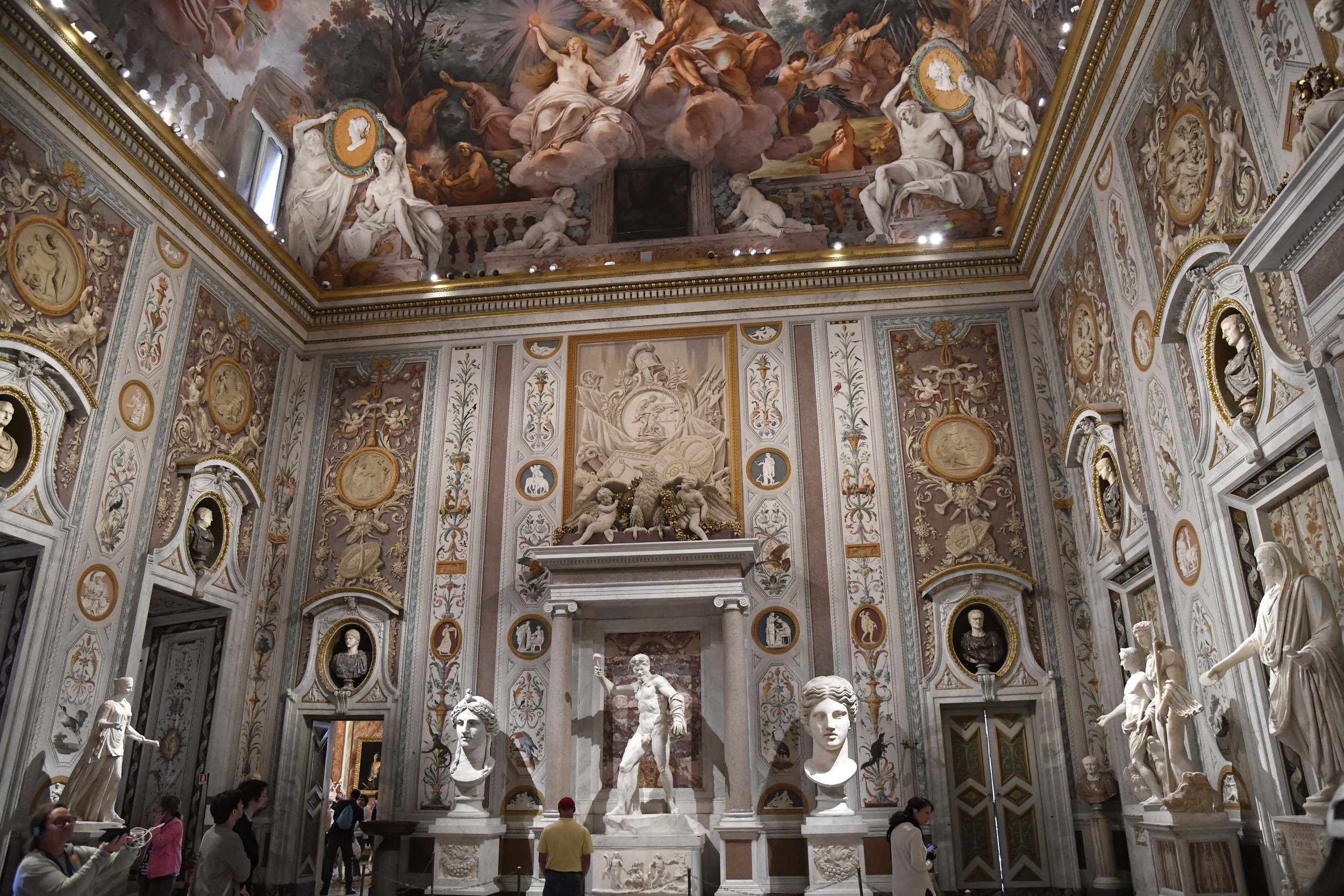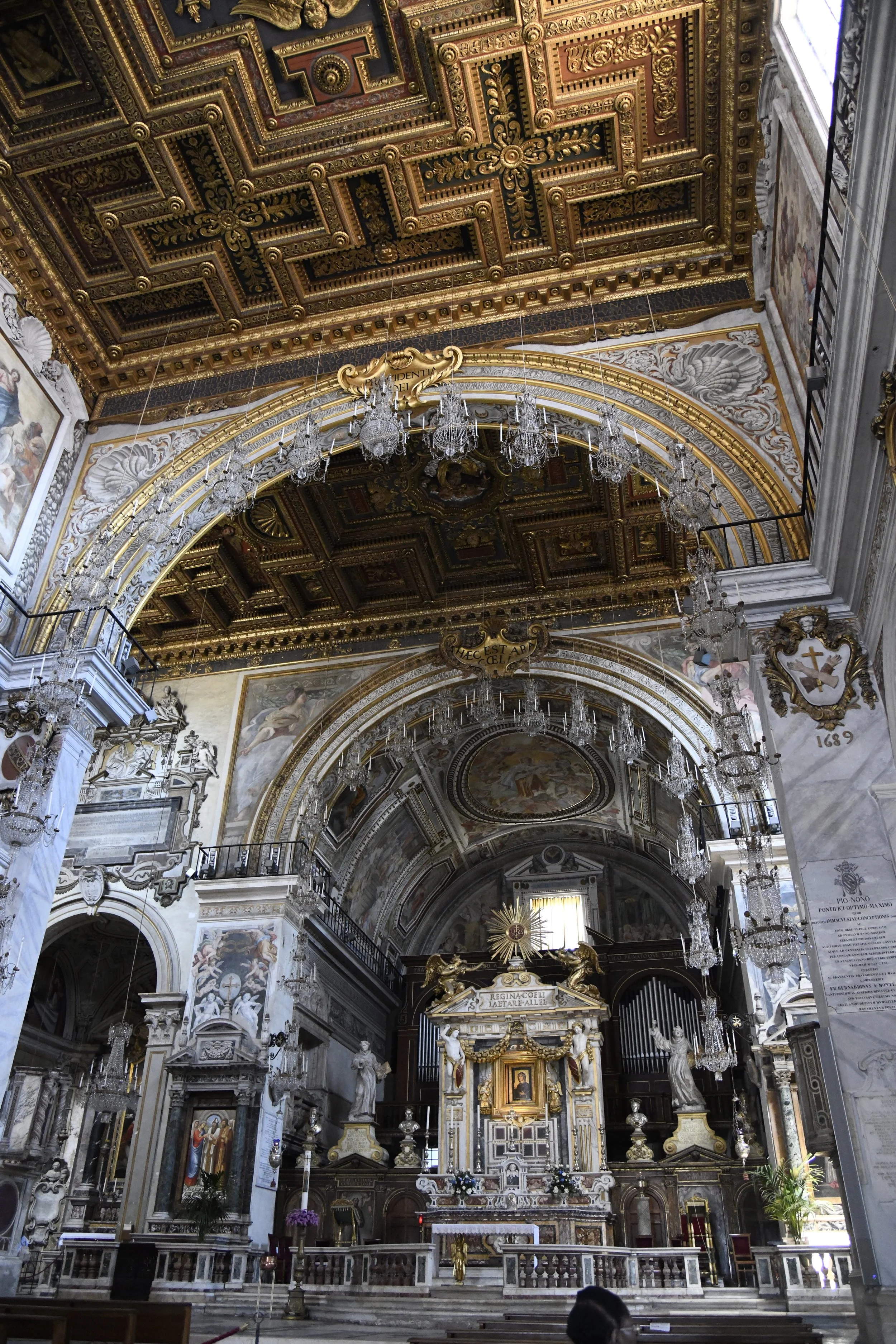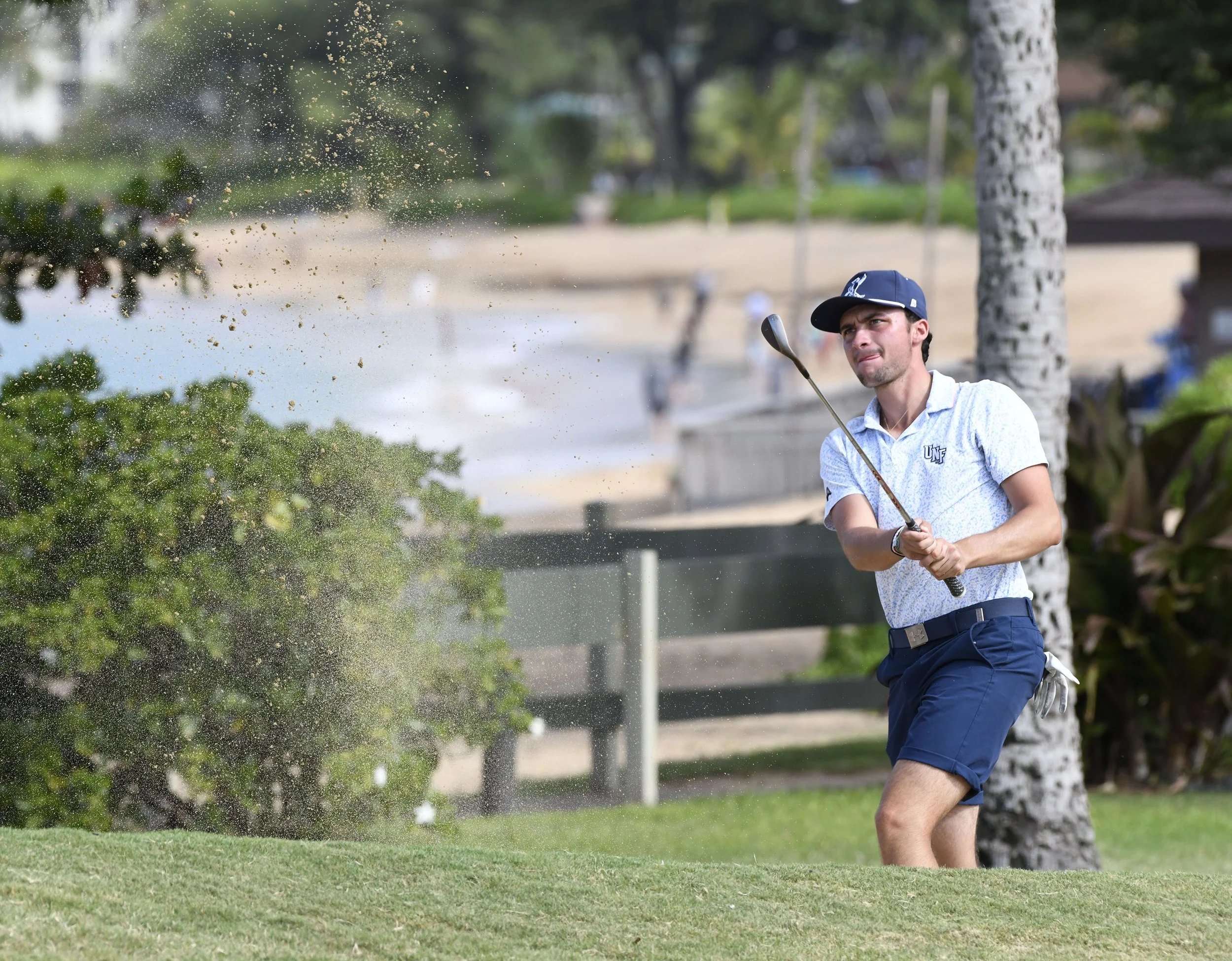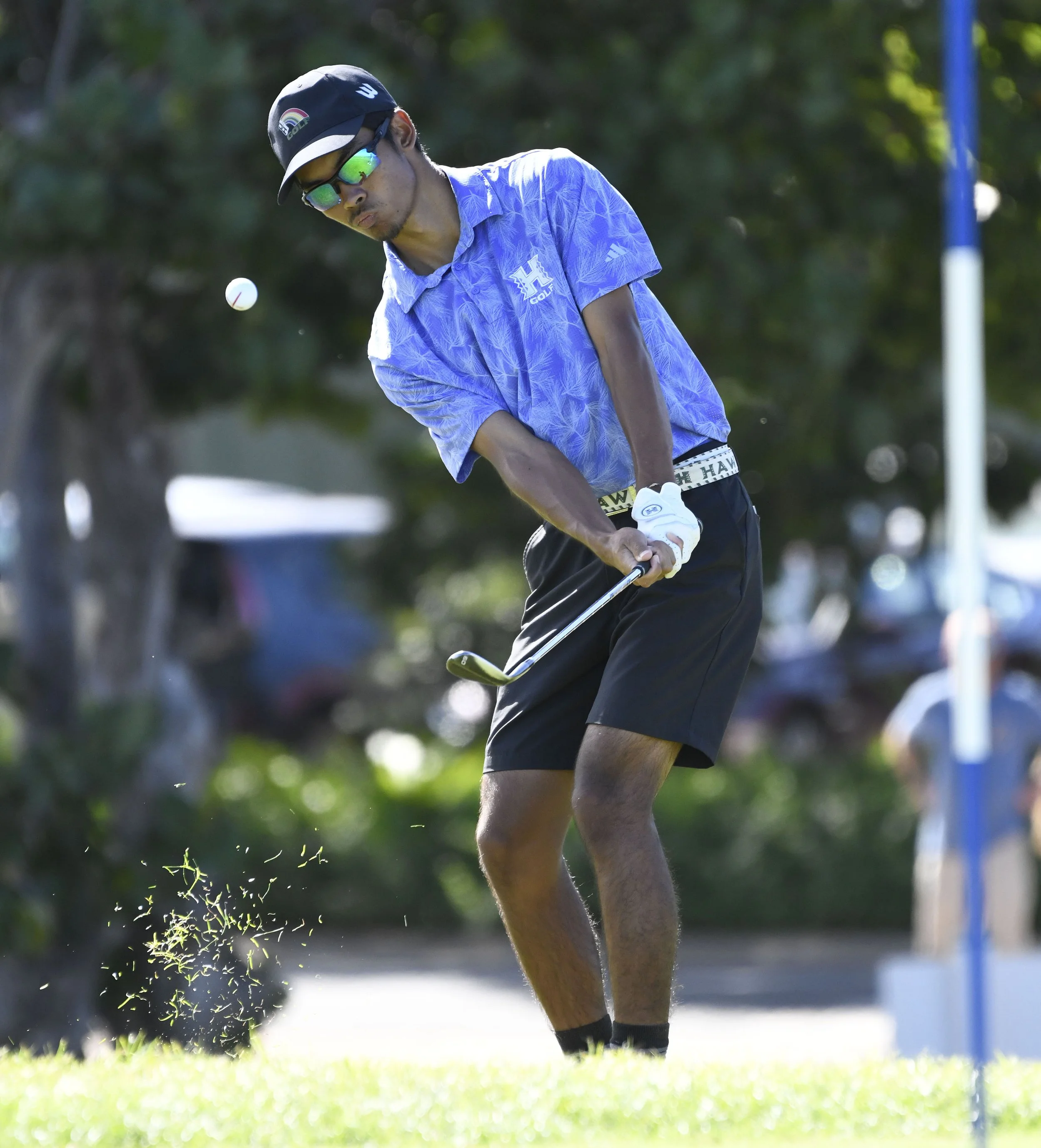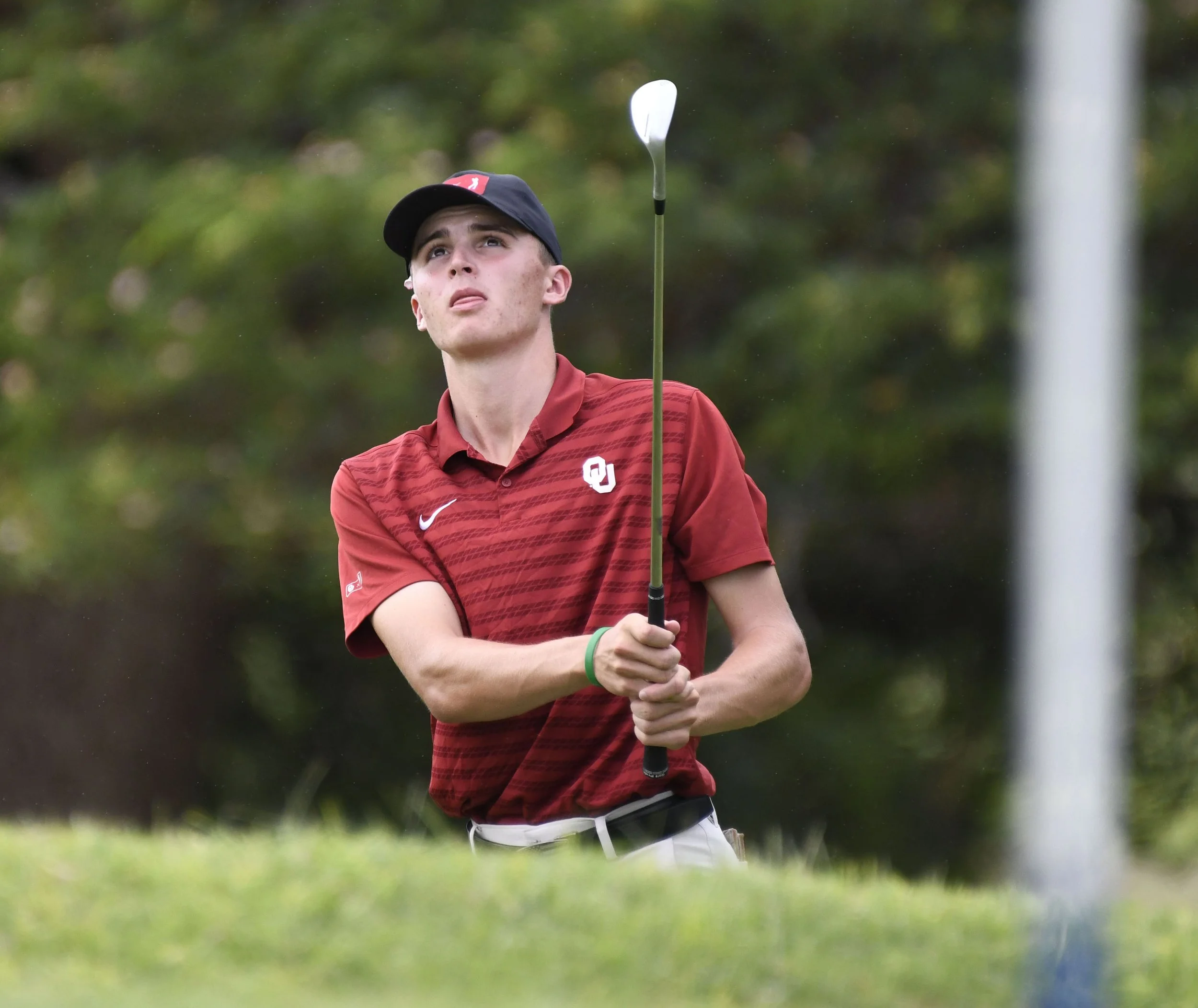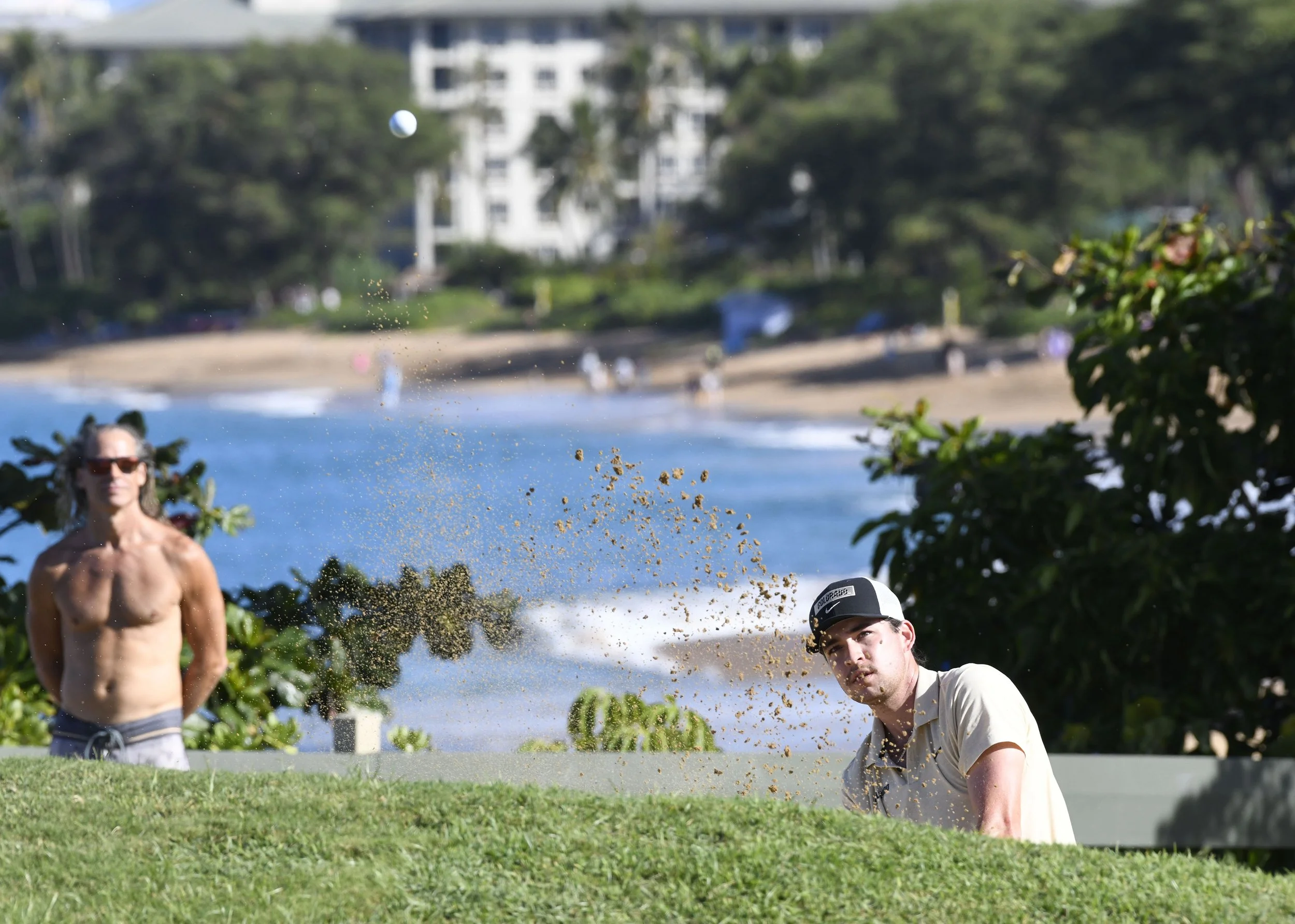Beavers, Hurricanes to play for Maui Classic title
Oregon State's Kelsey Rees uses a pump fake to get Western Kentucky defenders Josie Gilvin (right) and Zsofia Telegdy in the air in the third quarter Thursday. Rees, who was fouled on the play, scored 13 points in Oregon State's 80-58 win.
By MATTHEW THAYER
Host Oregon State led from start to finish to topple Western Kentucky, 80-58, in the annual Maui Classic women's college basketball tournament's opener Thursday evening at Seabury Hall's Erdman Athletic Center in Olinda. The win moved the Beavers to 4-7 on the year, while the Lady Toppers dropped to 8-2.
In the tourney's other opening-night game, University of Miami rolled past Nevada, 84-53, to improve to 10-1 on the year. Nevada fell to 5-7.
Miami's Natalija Marshall and Nevada's Kendra Hicks battle for rebound position on a first-quarter free throw Thursday.
The victories place Oregon State and Miami in tonight's championship final at Seabury. The championship game is scheduled to begin at 6 p.m., with consolation play between Nevada and Western Kentucky kicking off at 3:30 p.m. Tickets are free for the tournament presented by Vertical Sports Maui, but must be secured online. The stands were packed for both of Thursday's games and there are reportedly few tickets left for today's games.
Oregon State high scorer Catarina Ferreira is fouled by Western Kentucky's Zsofia Telegdy in the third quarter Thursday. Ferreira scored 26 points against the Lady Toppers.
Oregon State, which reached the Elite Eight in last year's NCAA Division I championship tournament, was paced by guard Catarina Ferreira, who poured in 26 points. Backcourt mate Tiara Bolden added 23 and forward Kelsey Rees chipped in 13. Western Kentucky was led by guard Destiny Salary's 21 points.
Miami's Haley Cavinder drives between Nevada's Victoria Davis and Audrey Roden in the first quarter of the Hurricanes' 84-53 win Thursday at Seabury Hall's Erdman Athletic Center. Cavinder scored a game-high 25 points.
Miami's Haley Cavinder, a dynamic 5-foot-6 guard out of Gilbert, Ariz., led her team in points, 25, rebounds, 12, and assists, 7. Nevada's Lexie Givens scored 18 points to lead the Wolf Pack.
(Note: University of Miami defeated Oregon State, 61-56, Friday to win the Maui Classic title. Cavinder scored 20 points and was named the tournament’s Most Valuable Player. In the game for third place, Western Kentucky topped Nevada, 80-70.)
Hālau Kekuaokalāʻauʻalaʻiliahi members Noelani Deguilmo (foreground) and Ka'iulani Quisaat perform hula to the song "Silent Night" during halftime of Thursday evening's game between Oregon State and Western Kentucky at Erdman Athletic Center.
Hālau Kekuaokalāʻauʻalaʻiliahi members Ka'iulani Quisaat (background) and Noelani Deguilmo perform hula to the song "Mele Kalikimaka" during halftime of Thursday evening's game between Oregon State and Western Kentucky at Erdman Athletic Center. Quinsaat is a Seabury Hall senior.
Oregon State head coach Scott Rueck stalks the sideline Thursday.
University of Miami head coach Tricia Cullop draws up a first-quarter play for her team Thursday.
Miami's Jasmyne Roberts drives for a first-quarter layup against Nevada in front of a large turnout at Erdman Athletic Center Thursday night.
Oregon State's defense awaits Western Kentucky's Alexis Mead as she dribbles upcourt in the first quarter Thursday.
Oregon State's Tiara Bolden drives past Western Kentucky's Alexis Mead for a second-half basket on her way to scoring 23 points.
Nevada's Audrey Roden is guarded by Miami's Haley Cavinder as she drives in the first quarter Thursday. Roden scored 16 points for the Wolf Pack.
Oregon State head coach Scott Rueck talks to his squad during a fourth-quarter timeout Thursday.
Miami's Natalija Marshall drives to score two first-quarter points Thursday against Nevada.
Alaska lives up to lofty reputation
Snowcapped Mt. Drum provides a backdrop as Glenn Highway nears Glennallen, Alaska. The 12,011-foot volcano is part of Wrangle St. Elias National Park.
Story and Photos by
By MATTHEW THAYER
Growing up in Kihei, a Hawaii town where temperatures never reach freezing, it was quite a transition for our son, Mark, to be posted in one of America's snowiest cities.
His first duty station in the United States Coast Guard (USCG) was in Valdez, Alaska. The small, remote hamlet at the head of Prince William Sound averages 326.3 inches of snow a year, enough to rank it in the top two snowiest towns in the U.S.
As one of the junior personnel, Mark spent three winters plowing snow from parking lots, streets and driveways for the USCG. A six-hour drive from Anchorage, the harbor town is nicknamed "Little Switzerland" in honor of its tall mountains and scenic beauty. Mark quickly grew to enjoy life in Alaska with all its outdoor activities and challenges, as well as the ability to jump in a vehicle and drive to hunting grounds or fishing holes 400 miles away.
This pullout along Glenn Highway proved to be a perfect place for a picnic lunch during a colorful fall drive from Anchorage to Valdez.
Following his stint in Valdez, Mark was transferred to Anchorage for four years. Serving as a Marine Science Technician, he spent his summers deploying to remote coastal villages all over Alaska's Far North region to help mitigate and prevent negative ecological impacts, such as fuel leaks and chemical spills. His mission continues with his latest posting on his home island of Maui.
As proud parents who always hoped to experience Alaska anyway, my wife Kelly and I were only too happy to fly up to visit our son. Driving, hiking, fishing, woodworking and serving as sherpas on bear, moose and bison hunts over six annual trips, we got to know the Southcentral region fairly well. We also dipped our toes into Alaska’s Interior long enough to shape some general impressions.
Water cascades through Virgin Creek Falls in Girdwood, Alaska. It is a short, easy hike to the falls. Virgin Creek Trail, which continues beyond the falls, is about a half-mile roundtrip through lush rainforest.
If you enjoy nature, it's hard to describe Alaska without sounding like a blurb from the state's travel bureau. Beautiful. Iconic. Wild. Roll the Colorado Rockies, Grand Tetons, Sierra Nevada and Northwest Canada into a ball, sprinkle in 100,000 or so glaciers, 175,000 moose and 140,000 bears and you get something approaching Alaska. America's largest state is not just big—it feels big. Its soaring mountains include the continent's tallest, Denali. Alaska's coastline is longer than the coastlines of all the other states combined. Admitted to the union as the 49th state in 1959, it is two and a half times larger than Texas.
As his years in Alaska added up, Mark's tour guiding skills improved. Visiting a resident means you not only get to take in recommended sights, but there can also be off-the-radar adventures like fishing at secret holes on the Kenai River, rafting down the Copper River in freezing October and four-wheeling long distances on dry riverbeds before the spring melt.
The tour boat Klondike Express passes in front of a Prince William Sound glacier during a cruise out of Whittier, Alaska.
A baby seal reclines on small iceberg floating in Prince William Sound.
Moose, bald eagle and bear are common sights in late spring and early summer, even in the cities. With the valleys cloaked in lush green and the mountains still shrouded in deep snow, that's where the food is. Fall trips brought changing leaves, northern lights, dropping temperatures and a memorable blizzard.
Perhaps the most common mammals spotted in Alaska from late spring to early fall are tourists. According to the Alaska Travel Industry Association, the state had 2.7 million visitors between May 2022 and April 2023. The visitors spent an average of 8.5 days in the state and generated $3.9 billion in direct spending. The Alaska Beacon reported that Alaska set a state record for cruise ship passengers in 2023, with 1.65 million passing through the port of Juneau. Of those, the article said, roughly 400,000 made the trip inland to Denali National Park and Preserve, many of them on the eight-hour train from Anchorage.
A bald eagle makes a sharp turn over Valdez, Alaska.
Denali provided one of our few Alaska disappointments. Due to its 20,310 feet of elevation and location, the majestic peak is blanketed by clouds up to 80 percent of the time. Ask anybody at the national park and they'll be quick to tell you how the mountain creates its own weather system.
We know people who caught Denali on crystal clear days. Several flew over its sun-soaked slopes in chartered planes and one even landed high on an expansive snowfield. To a person, they claimed it was an eye-popping experience.
Not so much for us. Thick clouds, rain and a bumpy five-hour bus ride through more of the same has been our experience. We visited the park for a few days and passed within a would-be view of the great mountain three other times. Hopefully, one of these days, we too will experience the mystical peak on a bluebird day.
Sprouting new horns, a young moose walks along a sidewalk at Anchorage's Kinkaid Park. The huge park at the edge of the city features 40 miles of walking trails, bike trails, athletic fields and plenty of wildlife.
If the mountain is clear while you're visiting, my advice is to do whatever it takes to get up in a plane to see Denali from the air. It is worth noting that the mountain is not visible from the national park headquarters or the Denali Depot train station no matter the weather. For that, you need to drive, take a bus or catch a glimpse from a distance, perhaps from Anchorage Airport 240 miles away.
Anchorage is the state's largest city by far. Sandwiched between the tall Chugach Mountains and Cook Inlet of the Pacific Ocean, it is home to nearly 300,000 people. The sprawling city is laid out in a grid pattern over fairly flat terrain and encompasses wooded parks, swamps and lakes.
A hike on a sunny day at the Eagle River Nature Center commands outstanding views. Forty minutes from Anchorage, the Nature Center includes river valley hikes of varying difficulty, ranging from easy to challenging. Another popular hike nearby is the 2.9-mile loop to the summit of Mt. Baldy.
Flanking the city is the huge Joint Base Elmendorf-Richardson where reportedly more than 30,000 service members, their families and retirees live. The military community makes up roughly 10 percent of Anchorage's population.
As expected of a city its size, even one so far north, Anchorage has a wide selection of amenities, including shopping, dining, movie theaters and cultural venues. Most of the restaurants pack a northern feel, but the multicultural city features cuisines like Bavarian, Thai, Japanese sushi and hearty halibut and steak. You can even buy Spam musubi at local gas stations. The outstanding Anchorage Museum located downtown is also well worth a visit. Its thoughtful exhibits offer windows into the host culture's practices, crafts, artwork and history, along with understandings of the diverse environments and surrounding seas.
The lower portion of the three-mile trail leading to the summit of Alaska's Flattop mountain is a relatively easy grade. Located about 30 minutes from downtown Anchorage, Flattop is reportedly the state's most climbed mountain. The going gets steep and tricky at the top. Proper gear and preparation are recommended for those hoping to reach the 3,281-foot summit.
A indigenous Alaskan harvests fall berries on the flanks of Qin cheghi, also known as Flattop Mountain.
Anchorage is a handy base for day-tripping or a good place to stock up on supplies before heading out on road trips or train travel. In mid-summer, the sun shines nearly all day long. Emerging from an Anchorage theater at midnight, I remember being surprised that it was barely dusk. Winter brings long nights, including only 5.5 hours of light on the winter solstice.
If you are planning an Alaska road trip, keep in mind just how big the state is. Unless you have unlimited time, or a penchant for driving 24/7, you can't do it all. Leave time on the itinerary to pull over and savor the views, to linger over picnics and maybe turn down a public road less traveled. As with most things in life, roaming Alaska is as much about the journey as the destination itself.
A spawning salmon leaps to clear a waterfall near Seward.
One of our favorite Alaska towns to visit is Homer. Located near the end of Sterling Highway, a nearly five-hour drive from Anchorage, the lively harbor town with postcard views reminds us a bit of Lahaina back in the day. Homer moves to its own vibe and rhythm. Kelly enjoys perusing the stores on "The Spit," while I hunt for photo opportunities amid the boats, beaches and blooming wildflowers. A highlight was eating raw oysters and fresh salmon while overlooking the sea at Captain Pattie's Fish House.
Homer's Spit juts 4.5 miles into Kachemak Bay. The narrow finger of land features activities and amenities that include: boating, restaurants, shops, hotels, beachcombing and fishing.
Lupines, or bluebonnets, bloom in early summer along the Homer Spit.
The drive to Homer from Anchorage is one postcard moment after another. We spotted at least 20 moose on one journey, with the sightings growing especially thick as we neared Homer. Motoring between the sea and snowcapped mountains, through forests and along lakes and rivers, the jaw-dropping views were punctuated on another journey by the bleak reality of a smoldering wildfire that had blackened many thousands of acres of woodlands. The road had only recently opened, and we were some of the first tourists to drive through.
Smoked salmon belly, capers and cream cheese top a slice of bread during a picnic below Exit Glacier, near Seward.
Seward is another harbor town at the terminus of a scenic highway. About a 2.5-hour drive from Anchorage and four hours by Alaska Railroad train car, Seward boasts the Alaska SeaLife Center aquarium, great hiking and access to the foot of glaciers. Restaurants were packed to the rafters when we visited, but we put our name on the list at Ray's Waterfront, explored the harbor for a while and then found places at the friendly restaurant's bar until it was our turn for a table. The wait became a time of fun conversation and sharing notes with fellow travelers.
A band of clouds dissipates over Turnagain Arm near Girdwood.
On the drive to both Seward and Homer, while rounding the coastline of picturesque Turnagain Arm, you pass near the town of Girdwood and the nearby Alaska Wildlife Conservation Center. Both are easy day trips from Anchorage. In Girdwood, we took the tram fronting the luxury Alyeska Resort hotel up to a scenic lookout for lunch. The area has pretty hikes, skiing in winter and a famous townie Cajun restaurant known for its huge portions, the Double Musky Inn. On another visit to Alyeska Resort's impressive grounds, we watched a mother black bear forage as her two cubs practiced climbing a tree.
A few hours at the Alaska Wildlife Conservation Center provides a chance to safely get up close to animals, including brown bears, wolves, elk, caribou and moose. For amateur wildlife photographers, this is a slam dunk.
The bear skin nailed to the ceiling over the Fairview Inn's bar is just part of the eclectic ambience of Talkeetna's no-frills watering hole.
Far inland from those towns, tiny Talkeetna seems like more of a place to briefly pause to refuel than a destination. That didn't keep us from booking rooms twice at the comfortable Denali Overlook Inn. With its huge windows and wide vistas, the inn is known for its stunning views of Denali. I cannot personally confirm that fact, though I did see pictures. A fun Talkeetna memory is quaffing a local draft brew and listening to a hot country band in the venerable Fairview Inn. Jimmie Rodgers and Merle Haggard were blaring from the speakers. A bear skin was nailed to the ceiling.
The road from Anchorage to Valdez winds through very pretty country as it skirts the Chugach Range. The lonely journey passes mirrored lakes and giant glaciers and winds down through scenic Thompson Pass. The last time we stayed in Valdez, its new cruise ship terminal was under construction. Now that the dock is open for summer seasons, I wonder what changes the cruise industry has brought to the sleepy town across the fjord from the terminus of the Alaska Pipeline. The squared-away little municipality with one grocery store, a bustling post office and very well-stocked Ace Hardware felt like a throwback to the 1950s.
A fisherman lets out net in Prince William Sound.
Nuts and Bolts
If roughing it is your idea of fun and if you don't mind covering long scenic distances to get from place to place, Alaska is well worth visiting. At least, it is for those who can afford it. Alaska is by no means a bargain destination. We found prices for food, goods and entertainment about on par with, or more than, what we pay in Hawaii. Both states are at the end of supply lines. In Alaska, the farther afield you go, the more you'll pay for everything from hamburgers to gasoline.
The author and wife, Kelly Thayer, pose with their son, Mark Thayer, after a day of salmon fishing at a semi-secret spot on Alaska's Kenai River. (Photo by a fellow fisherman)
If you plan to visit during Alaska's summer high season, it's recommended to make car, room and activity reservations ahead of time. Put it off, and nothing may be available, or you'll pay dearly for what is left. Off season is a different story. If you're traveling then, you may want to confirm what is open. A lot of stores, restaurants, lodgings and activities close once tourism winds down. Towns like Valdez roll up pretty tight for winter.
The Northern Lights glow over the horizon during a fall rafting trip down Alaska's Copper River. A crackling fire provides relief from temperatures that dipped to 12 degrees that night–considered balmy compared to when it really gets cold in the 49th state. The Big Dipper constellation, featured prominently in the state's flag, is visible top left.
Summer weather in Alaska is variable and unpredictable. Winter is determined to kill you. Whatever the season, mistakes can be fatal. As can encounters with bear and moose. When in doubt, ask a local for advice. They may share a bit of wisdom that our son, Mark, adopted as he acclimated to the harsh winters: "There's no bad weather, just bad gear."
I would say it pays to have a solid lay of the land before putting that adage to the test. Alaska is a big state full of challenges that match its outsized beauty.
An Alaskan moose shares a tender moment with her baby. (Kelly Thayer photo)
A bald eagle soars over Valdez, Alaska.
Colorful foliage lines a lower section of trail at Flattop Mountain.
Poinsettia woes challenge college Ag students
One of the healthier poinsettia plants on display Saturday awaits the start of the annual fundraiser for the University of Hawaii Maui College’s Agriculture and Natural Resources Department.
Story and Photos
by Matthew Thayer
Walking a tightrope between feast and famine with every crop, farmers are some of the biggest gamblers on Earth.
There are no guarantees of a return when they lay down their money for seed and supplies. Nor when they put their hearts into planting and caring for whatever crop they are growing. If all goes well, the harvest comes in and they turn a profit. Maybe not as much as the middlemen and sellers down the road, but enough to get by. The gamble is that a single miscue or cruel twist of fate can mean the loss of all or most of that investment in money, hope and effort.
University of Hawaii Maui College (UHMC) Agriculture and Natural Resources students learned this lesson the hard way with this year's annual poinsettia-growing project. An assortment of challenges—ranging from insects and break-ins to a wonky irrigation system and holes in the greenhouse's roof—made the project to turn seeds into finished commercial products difficult from the start.
A sparse selection of spindly, marked-down poinsettia plants is what is left after the first wave of customers at the annual holiday plant sale.
The annual sale that culminates the project kicked off Thursday and concluded Saturday morning. While the fundraiser has always been one of the island's secret hacks to scoring the holiday season's biggest and healthiest poinsettia plants, this year's offering did not match those standards.
"Our greenhouse has been damaged by wind and other things," said Agriculture Department Lecturer Amy Cartwright. "We have a lot of holes that are letting in the insects. The wind blew over plants a lot, so you'd find them on the ground. So, we have had issues with whitefly and wind, and our irrigation system was being finicky."
A week before the sale, she said, disaster struck.
UHMC Lecturer Amy Cartwright tapes an updated price list to a greenhouse table Saturday. Four-inch potted plants were going for $6 and six-inch pots for $7.
"We show up after one day and nothing had been watered. And that's what happened with all of these. They were beautiful and then last week there's just no water. After one day."
Proceeds from the sale are traditionally pumped back into the Agriculture Department to support its programs and students. Along with poinsettias, this year’s sale also featured native plants and value-added products, such as bottles of student-processed honey. Saturday's event was part of a big day on campus, with the annual Maui Comic Con and UHMC Art Department Ceramics Sale also being held.
A morning rush of customers passes through the greenhouse after the gate is opened to start Saturday's public sale.
Unwilling to give up after their crop took its big hit, Agriculture Department staff, students and volunteers did their best with what was left.
"We started in the thousands," Cartwright said. "But it ended up with about 200 plants for each variety we planted." (About 1,200 spindly, heavily pruned plants.)
Agriculture and Natural Resources Program Coordinator Mach Fukada said the problems and the scramble to rebound provided valuable lessons.
"That's why this is for the students, they got to see the reality," Fukada said. "Everybody comes into ag with, as (former department head) Ann Emmsley would always say, 'rainbows and bluebirds and unicorns.' You think, oh yes, it's all sunshine and whatever, and they don't ever see the gritty underbelly. Oh man, failure is always an option. That is the reality. It is better for students to fail here than to fail on their own, and after they have invested lots of money and they're in the hole and losing. This is the perfect place."
Fukada said it is all about taking those lessons and moving forward.
"Failure is an opportunity to learn. In the real world, failure means: ‘oh, you lost money and now you're broke ass.’ That's the reality."
Second-year agriculture student Shauna Beaulieu puts a paper collar around a poinsettia plant for a customer Saturday.
Second-year agriculture student Shauna Beaulieu was part of the friendly crew helping customers in the greenhouse Saturday. A line of about 45 people streamed through the gate the moment it opened. One table held a cluster of pink poinsettias that seemed to have come through the many trials a bit healthier than their red and white cousins. Those were scooped up fast. Customers then began sorting through what was left.
"There were challenges the whole year," Beaulieu said. "We had to just maintain. It was learning about challenges and how to overcome. I think we cleaned it up pretty good."
UH-Maui junior Dylan Thompson wheels a cart of poinsettia plants to the checkout lane for a customer. Holes in the agriculture program's greenhouse roof and walls are visible in the background.
Kihei shopper Kathy Harman said she hits the sale every year.
"I want to support the school because they do a wonderful job," Harman said. "You want to support the school and support the community."
Fukada said the department hopes to "reskin" the greenhouse and redo the irrigation system soon. It also needs to fix its tractor, which was damaged by vandals who cut the diesel fuel line trying to steal what they probably thought was gasoline.
"We've had problems with people breaking in," Fukada said. "They cut the fuel line on the tractor and we have not been able to get that fixed."
The sale’s most presentable plants line the fronts of greenhouse tables before it opens to the public Saturday.
Cartwright said community members wishing to help the Agriculture Department could consider volunteering to help improve and clear outdoor farm field areas on the campus where native plants are to be planted. It could also use help collecting native seeds and planting them. She said the department is offering a tuition-free class next semester titled Weed Science, which will delve into the island's most problematic invasive plant species.
She said setbacks will not spell the end of the annual holiday plant sale.
"Hopefully we can get the greenhouse fixed and we can get the poinsettias looking great again," she said.
State Champion Warriors
Kamehameha Maui players hoist their school's first state football championship trophy after beating Kaiser, 37-14, Saturday at Mililani.
Story and photos by
Matthew Thayer
The Warriors of Kamehameha Maui rode the arm of quarterback Kolten Waikiki-Caldeira, the legs of running back Zedekaiah Campbell and the heart of a stout, hard-hitting defense to earn their school’s first state football title with a convincing, 37-14, win over Kaiser High School in the First Hawaiian Bank-HHSAA State Football Division II championship game at Mililani High’s John Kauinana Stadium Saturday night on Oahu.
Waikiki-Caldeira passed for three touchdowns, going 8-of-14 for 87 yards. He also scored on a one-yard run. Campbell rushed for 239 yards, including a 35-yard touchdown. Many of those yards came after contact, with Campbell either breaking loose or dragging defenders with him. The defense held Kaiser in check for most of the game apart from two second-quarter touchdown passes from quarterback Caleb Hamasaki to wide receiver Jesse Shinagawa.
Water flies as Kamehameha Maui players celebrate winning their school's first state football championship Saturday at Mililani.
As the game clock ticked down to zero, celebrating players doused head coach Ulima Afoa with a cooler of ice water and squirted bottled water high into the air.
Still wet and smiling after doing his press interviews and heading off to join his family and team, Afoa already seemed to be looking ahead to seasons to come.
“It’s the first state championship that we have in football,” Afoa said. “Hopefully it becomes part of their mindset and they compete and, you know, do the things that you need to in order to be in this position. I think that’s what it’s all about, pushing the school forward.”
Afoa said after Kaiser scored the two late touchdowns to suddenly make what looked like a runaway a close game, the message to his team at halftime was simple.
“Just continue to play,” Afoa said. “You’ve got to let that stuff go.”
Kamehameha Maui quarterback Kolten Waikiki-Caldeira releases a second-quarter touchdown pass. He threw for three scores and ran for another.
Standout junior offensive lineman Pa’u Spencer said the Warriors’ third time in the state championship game proved to be a charm.
“It feels amazing,” Spencer said. “I get to play for my family. I get to play for my brother (Kale Spencer), who got whipped by Kapaa. I get to play for the seniors from last year, that we unfortunately lost to Waimea. I just get to create a legacy.”
Kamehameha Maui's Zedekaiah Campbell takes Kaiser's Zane Shinkawa for a ride.
Campbell said he was still in disbelief over his big night.
“I don’t even know where this came from, I just came out and played, man,” Campbell said. “Big shoutout to my O-line, without them I wouldn’t have even half of these yards.”
Kamehameha Maui receiver Tevyn Apo caught five passes for 50 yards and two touchdowns. Frank Abreu caught a one-yard touchdown pass for the Warriors and Kayden Yap kicked a 38-yard field goal.
Kamehameha Maui's Tevyn Apo hauls in a first-quarter touchdown pass over Kaiser's Kolt Gilpa.
Kamehameha Maui's Tevyn Apo celebrates with teammate Isaiah Lani after catching a first-quarter touchdown pass in Saturday's D-II state championship game at Mililani High School's stadium.
Injured team captain Kaonohi Casco (with hat) gives his teammates a pep talk before the start of the second half Saturday at Mililani.
Kamehameha Maui outstanding offensive lineman Pa’u Spencer leaves the field with a smile after blocking on a touchdown run.
Kamehameha Maui head coach Ulima Afoa is drenched at the end of Saturday's championship win.
Head coach Ulima Afoa and his players bask in their trophy-winning moment.
Kamehameha defense ballhawk Anthony Sardine Jr. looks to the sidelines after his second-half interception.
Kamehameha Maui's Zedekaiah Campbell bowls over Kaiser's Zane Shinkawa.
Kamehameha Maui quarterback Kolten Waikiki-Caldeira releases a second-quarter pass.
Auburn dances to Maui Invitational title
Celebrating Auburn players break into a hula during the Maui Invitational championship trophy presentation ceremony Wednesday at Lahaina Civic Center.
By Matthew Thayer
The championship final of the Maui Invitational at Lahaina Civic Center turned into a dance party for the Auburn Tigers as they waltzed past Memphis, 90-76.
Auburn took control early, leading by as many as 22 points, and cruised to the lopsided win to earn the school its first Maui title. The players were dancing on the sidelines in the closing moments, with head coach Bruce Pearl briefly getting in on the act, and they danced at center court after the final whistle. As the team gathered for a group photo after the trophy presentation, there was even a bit of hula.
Standout center Johni Brome was named the Tournament MVP after scoring 21 points, grabbing 16 rebounds, blocking four shots and handing out six assists.
PJ Haggerty of Memphis was the game’s high scorer with 27 points.
In other games Wednesday: Michigan State outlasted North Carolina, 94-91, in overtime to take third place, Iowa State secured its second tourney win by pounding Colorado, 99-71, and Dayton won the seventh place game over two-time defending National Champion UConn, 85-67. The UConn Huskies entered the tourney ranked No. 2 in the country and left with three losses and a last-place finish in a stacked field at the Maui Invitational.
Auburn players dance after the final whistle of Wednesday's 90-76 win over Memphis in the Maui Invitational championship final at Lahaina Civic Center.
Auburn head coach Bruce Pearl celebrates with his players in the closing moments of the championship game.
Auburn's Chad Baker-Mazara drives for a second-half basket against Memphis.
Auburn's Johni Broome blocks a first-half shot by Memphis' Dain Dainja. Broome scored 21 points, grabbed 16 rebounds, had four blocks and six assists and was named tournament MVP.
Auburn's Tahaad Pettiford draws a foul as he drives between Memphis' Colby Rogers (left) and Dain Dainja in the second half.
Auburn players and staff pose for a group photo after their championship victory.
Auburn’s Johni Broome (left) and Dylan Cardwell pose with Maui Invitational hardware after their team's 90-76 win over Memphis in Saturday's championship final. Broome holds the MVP trophy and Cardwell the perpetual Wayne Duke Championship Trophy.
A tale of two Tigers
Seven-month-old North Carolina fan, Nina Martin, wears protective headphones while taking in Tuesday night's semifinal game between the Tar Heels and Auburn in noisy Lahaina Civic Center. Her parents said they met at Chapel Hill while attending the University of North Carolina.
By Matthew Thayer
Even before the Maui Invitational championship final starts, it is guaranteed that Tigers will win the title. The only question is, will it be the Tigers from Memphis or the Tigers from Auburn?
Memphis and Auburn punched tickets to the championship game with statement wins over legendary programs Tuesday.
Memphis used its length and athleticism, as well as the outstanding shooting of guard Tyrese Hunter, to defeat Michigan State, 71-63, in the day’s first semifinal game. Hunter scored a game-high 23 points, many of those in the face of a smothering Spartan defense.
Auburn took down North Carolina in the day’s second semifinal, 85-72. The championship game is scheduled to be played Wednesday, Nov. 27, at noon HST.
Memphis' Colby Rogers is guarded closely by Michigan State's Jeremy Fears Jr. as he drives in the second half.
In the consolation bracket, Colorado squeaked by two-time defending National Champion UConn, 73-72, and Iowa State topped Dayton, 89-84. For No. 2 UConn it was the second Maui Invitational loss in a row, sending the Huskies to the seventh-place game against a tough Dayton team with a chance to finish last in the tourney.
Auburn's Johni Broome out-jumps North Carolina's Jalen Washington to win the opening tipoff at the start of their semifinal game at Lahaina Civic Center. Broome scored a game-high 23 points for the Tigers.
Auburn's Tahaad Pettiford drives on North Carolina's Jalen Washington in the first half.
A first-half dunk by Tar Heel Jalen Washington electrifies the North Carolina fans at Lahaina Civic Center Tuesday night.
Ball boy Braxton Kava, 9, spins a ball on his finger during the halftime break in Maui Invitational semifinal game between Memphis and Michigan State. Kava is a third grader at Kamalii Elementary School. His dad said he learned trick only last week.
Auburn head coach Bruce Pearl exhorts his layer in the first half against North Carolina.
Auburn’s Chad Baker-Mazara shoots over North Carolina’s Seth Trimble.
Memphis center Moussa Cisse throws down a dunk against Michigan State in the first half.
Memphis fans try to put the hex on a Michigan State player as he shoots a foul shot.
Memphis head coach Penny Hardaway calls out to his players in the second half.
Michigan State's Jeremy Fears Jr. drives for a first-half basket against Memphis.
Lahaina Civic Center is packed for Tuesday's first semifinal game between Memphis and Michigan State. It has been a full house for every game played this year.
Michigan State's Tre Holloman dribbles upcourt against Memphis.
Memphis guard Tyrese Hunter drives in front of Michigan State's Carson Cooper in the first half. Hunter poured in 23 points to lead his team in scoring as the Tigers defeated the Spartans, 71-63, to reach the Maui Invitational championship final.
Iowa State's Keshon Gilbert drives to score a crucial late basket to help seal the Cyclones' 89-84 win over Dayton in the day's second consolation bracket game at Lahaina Civic Center. Gilbert scored a game-high 23 points.
Dayton's Zed Key dunks late in the second quarter against Iowa State to score two of his 15 points.
Memphis Tigers outlast two-time National Champion UConn to kick off Maui Invitational: Day One coverage
Memphis' PJ Haggerty is fouled in overtime as he drives between UConn's Samson Johnson (35) and Liam McNeely.
By Matthew Thayer
Led by head coach Penny Hardaway, a former tournament co-MVP, the Memphis Tigers pulled off an opening round, 99-97, upset in overtime of two-time defending National Champion UConn to highlight the opening day of the Maui Invitational mens college basketball tournament at Lahaina Civic Center.
Hardaway was co-MVP in 1992, sharing the trophy with Duke’s Bobby Hurley, brother of current UConn head coach Dan Hurley. Memphis was led by guard Tyrese Hunter’s 26 points, while Tarris Reed Jr. paced UConn with 22. UConn was ranked No. 2 in the country, while unranked Memphis was not in the Top 25. Hardaway later called the victory the biggest win of his college coaching career.
Memphis head coach Penny Hardaway looks like he's throwing a shaka while calling out a play against UConn. Hardaway was named co-Tournament MVP with Duke’s Bobby Hurley when he played in the tourney in 1992 for the Tigers.
This year’s Maui Invitational marks a return to Lahaina Civic Center after the tourney was moved to Oahu last year in the wake of Lahaina’s devastating wildfires that destroyed much of the town, claimed 102 lives and displaced 10,000 people.
In other games: No. 25 Michigan State thumped unranked Colorado, 72-56; No. 4 Auburn roared back to beat No. 5 Iowa State on tip-in rebound with seconds to go; No. 12 North Carolina rallied in the second half to beat Dayton in a nail-biter, 92-90. It was the second-largest comeback in the storied program’s history. Memphis and Michigan State are set to play in one semifinal Tuesday, while North Carolina will meet Auburn in the other. The two winners of those games will clash in the championship final scheduled to be played Wednesday, starting at noon HST at Lahaina Civic Center.
Memphis' Colby Rogers shoots a three-pointer to tie UConn in overtime and set his team up for the upset, 99-97, opening-round win.
UConn head coach Dan Hurley argues a call Monday.
UConn's Solo Ball drives for a first-half basket against Memphis.
UConn's Jayden Ross (23) and Solo Ball celebrate after Ball's three-point shot to force overtime against Memphis.
UConn's Alex Karaban shoots over Moussa Cisse of Memphis.
Memphis forward Nicholas Jourdain dunks against UConn in the first half.
Memphis players celebrate their 99-97, overtime win over two-time defending national champion UConn Huskies Monday in the opening game of the Maui Invitational mens college basketball tournament at Lahaina Civic Center.
North Carolina's RJ Davis gathers himself before shooting the game-winning free throws with 4.3 seconds left against Dayton Monday. Davis scored 30 points to lead his team in scoring.
North Carolina fans celebrate as their team roars back to take the lead late in the second half against Dayton.
Dayton's Malachi Smith is fouled by North Carolina's Ian Jackson in the first half.
North Carolina head coach Hubert Davis shouts to his team in the first half of Monday's game against Dayton.
North Carolina's Seth Trimble lays in a first-half basket.
North Carolina's Elliot Cadeau slips while driving against Dayton's Javon Bennett.
Dayton's Isaac Jack and North Carolina's Jalen Washington battle for position.
Michigan State fan Todd Szkotnicki wears a turkey hat as he roots for the Spartans in their game against Colorado.
Legendary Michigan State head coach Tom Izzo talks to a referee during Monday's opening round, 72-56 win over Colorado.
Michigan State's Carson Cooper (15) battels for rebound position with Colorado's Assane Diop.
Michigan State's Szymon Zapala grabs a first-half rebound over Colorado's Elijah Moore.
Colorado's Julian Hammond III drives against Michigan State's Tre Holloman.
Dancers from the Sheraton Maui Nui Luau of Tihati Productions perform during halftime of Monday's game between Michigan State and Colorado.
Auburn's Johni Broome follows through on a first-half shot over Iowa State's Dishon Jackson. Broome led Auburn in scoring with 22 points.
Iowa State's Nojus Indrusaitis goes to the floor after being fouled in the first half of the Cyclones' opening-round game against Auburn.
Iowa State's Dishon Jackson is pumped up after dunking against Auburn's Dylan Cardwell and JP Pegues in the first half.
Iowa State's Curtis Jones is defended by Auburn's Miles Kelly.
Kamehameha Maui dominates Roosevelt to reach state title game
Kamehameha Maui's Zedekaiah Campbell (right) tosses the ball to an official after scoring on a 48-yard first-quarter touchdown run against Roosevelt in Saturday night's 60-26 win over Roosevelt High School in the First Hawaiian Bank/HHSAA state semifinal playoff game at Kanaiaupuni Stadium. The victory clinched a berth in the state Division II championship game against Kaiser set for Saturday on Oahu. Campbell scored two touchdowns in the game.
By Matthew Thayer
The Warriors of Kamehameha Schools Maui punched their ticket to another First Hawaiian Bank/HHSAA State Football Championships Division II championship game with a convincing 60-26 win over visiting Roosevelt High School Saturday night at Kanaiaupuni Stadium in Pukalani.
Kamehameha Maui dominated the game, scoring touchdowns on a blocked punt, two long kickoff returns, two touchdown runs and an interception return. Kamehameha outgained Roosevelt 242 yards to 23 on the ground. Forced to pass early and often, the Roughriders had 370 yards passing to Kamehameha's 12. Kaikea Hueu had 124 yards rushing and a touchdown for the Warriors, while teammate Zedekaiah Campbell chipped in with 121 yards and two TDs.
The top-seeded Warriors are scheduled to play Kaiser High School, which won Saturday's other D-II semifinal, 16-13, over Kauai at Vidinha Stadium on Kauai. The title game is set for 4 p.m. Saturday at Mililani's John Kauinana Stadium on Oahu. Kamehameha Maui played in last year's D-II final, losing a heartbreaker to Waimea, 31-28.
Kamehameha Maui's Kaikea Hueu celebrates with teammate Isaiah Lani after scoring on 44-yard run in the third quarter Saturday against Roosevelt.
Roosevelt wide receiver Keawe Davis leaps to haul in a third-quarter pass over Kamehameha Maui's Keanu Lanoza. Davis caught three touchdown passes in the game. He had 12 receptions for 178 yards.
Kamehameha Maui's Ramzen Fruean blocks a pass by Roosevelt quarterback Kaeo Bush.
Kamehameha Maui kicker Kayden Yap attempts a 33-yard field goal out of the hold of Kolt Kahoohanohano in the third quarter.
Kamehameha Maui kicker Kayden Yap joins holder Kolt Kahoohanohano in watching his 33-yard field goal split the uprights in the third quarter. He also converted a 45-yard attempt in the first quarter.
Kamehameha Maui standout offensive linemen Pau Spencer is pumped up after teammate Kayden Yap kicked a 45-yard field goal in the first quarter.
Kamehameha Maui head coach Ulima Afoa talks to his team after the final whistle of Saturday's 60-26 win over Roosevelt.
Kamehameha Maui's Kaiwa Ho blocks a punt in the end zone by Roosevelt's Ioane Kamanao early in the first quarter to set the tone for Saturday's state semi-final playoff game. The ball was recovered by the Warriors' Anthony Sardine Jr. for a touchdown.
Official Lionel Montalvo signals touchdown after Kamehameha Maui's Anthony Sardine Jr. (12) pounced on a blocked punt in the end zone in the first quarter. The Roosevelt High punt was blocked by Kamehameha Maui's Kaiwa Ho.
Kamehameha Maui assistant coach Kevin O'Brien praises the special teams unit after it stopped a punt from rolling into the end zone to pin Roosevelt on its own goal line in the first quarter. Four plays later, a blocked punt by the Warriors scored the game's first TD.
Kamehameha Maui's Zedekaiah Campbell celebrates with teammates after scoring on a 48-yard first-quarter touchdown run.
Kamehameha Maui's Tevyn Apo is cheered by the sold-out crowd as he scores on a 90-yard kickoff return to start the third quarter Saturday. He also scored on an 89-yard kickoff return in the second quarter.
Kamehameha Schools Maui's marching band leads the football team onto the field before the start of Saturday's game.
Roosevelt quarterback Kaeo Bush is sent flying by Kamehameha Maui defenders Titus Joaquin (left) and Rusty Ako-Nataniela after releasing a first-quarter pass.
Maui's complicated love affair with tourism
A view from the sidelines
A commercial airliner is silhouetted by a Maui sunset. Airlines play an important role in Maui’s tourism-based economy.
Story and Photos by
By MATTHEW THAYER
It was obvious Maui tourism was in the middle of a growth spurt when I moved to the island as a young photojournalist in 1980, but I don't think any of us expected the visitor industry to burgeon so quickly into a global powerhouse.
In those days, sugar cane and pineapple plantations dominated the landscape. Farm machinery rumbled across roads and massive cane fires belched towering mushroom clouds of smoke. The middle of Kahului smelled like a pineapple thanks to Maui Pine's tin-roofed cannery.
Anyone on the Valley Isle who wanted a job could get one. Or two or three, for that matter. The service industry was already the island's biggest employer, but working at the mills and plantations was how many folks got ahead. Big agriculture provided training programs and avenues for advancement. Workers bought homes and put kids through college. There was hope that Maui's bucolic way of life could carry on forever.
Traffic stops as an empty Hawaiian Commercial & Sugar Tournahauler lumbers across Mokulele Highway in 2011.
Smoke from a towering cane fire nearly blocks out the sun in 1999.
In hindsight, the plantations and tourism were already speeding in opposite directions, one elevator headed to the penthouse and another to the basement of history.
The posh Hyatt Regency Maui Resort and Spa opened in Kaanapali in 1980, setting a new island standard for architectural scope and investment. My friends and I used to play tourist by lounging at the fancy pool with its waterfalls and grottos. The Hyatt's disco, Spats, was Maui's hottest spot to dance and party.
The island was transformed over the next 10 years. At the close of the 1980s, Maui was deep into a construction boom and tourism was its unquestioned economic driver. Major hotel and condo projects were either underway or wrapping up in Wailea, Kapalua and Kaanapali. The bedroom communities of Kahului, Wailuku and Kihei were exploding in size. West Maui, Pukalani, Haiku and Kula were also swelling to meet housing demands for both locals and the influx of newcomers.
With a miniscule unemployment rate and thriving economy, even with its plantations fading away, Maui had plenty of jobs to go around. Some were filled by immigrants from the Philippines and others by young Californians fresh out of school. Opportunity lured all sorts of people from around the world to Maui.
The opulent, art-filled Grand Wailea Resort reportedly cost Japanese developer, Takeshi Sekiguchi, $650 million to build when it opened in 1991. It sold in 1998 for a reported $263 million.
On the shoulders of this army of workers, new luxury properties like the Grand Wailea Resort, The Ritz-Carlton Maui Kapalua and Four Seasons Resort Maui at Wailea elevated Maui's worldwide reputation as a premier destination. Not only was it a beautiful, sunny island with amazing sights and beaches, the people were friendly and the service was outstanding. Properties enlisted some of the industry's top minds to run things. Workforce training was offered in high schools and the local community college. University of Hawaii Maui College's excellent culinary arts program continues to be a pipeline for young island chefs and bakers.
Starting at least as early as the 1980s, ad campaigns promoted Maui as "no ka oi." The best. The island began playing host to multiple televised sporting events each year, including professional golf, college basketball and football, world triathlon and surf championships. Spliced within the hundreds of free promotional hours were cutaway shots of humpback whales breaching, surfers riding giant aqua blue waves, sunrise at Haleakala and hula dancers performing at luaus.
Golf fans watch the SBS Tournament of Champions leaders approach the Kapalua Plantation Course's 18th green on the final day of the PGA tourney in 2010. The annual event held the first week of January every year is now sponsored by Sentry Insurance.
Cast members of the Old Lahaina Luau perform at halftime of a Maui Invitational mens college basketball game at Lahaina Civic Center in 2009.
The tourism concept first pitched to Mauians in the 1960s and '70s envisioned vacationers loosely corralled in resorts where they spent their time and money using amenities like golf courses, tennis courts, pools, spas, restaurants and nearby beaches. Impacts on the community would be limited. That hopeful notion was put on life support by millions of free and independent travelers bent on renting convertibles and Jeeps to explore the island. The publication of a bestselling book revealing all of Maui's secret hikes and haunts shoveled dirt over its grave.
Visitors in convertibles navigate winding Hana Highway in 2008. One far destination on the road, the Kipahulu District of Haleakala National Park, reports welcoming an average of 800,000 people a year, which equates to about 500 cars added to local traffic each day. The scenic drive is one of the most popular tourist activities on the island.
Tourism's impacts encroached even further afield when homeowners, often new buyers, began renting out their properties as bed and breakfasts. Quiet neighborhoods suddenly had loud parties at night. B&Bs were blamed for siphoning inventory out of an already stressed long-term rental market and for driving up rents and home prices.
The view near the 10,000-foot summit of Haleakala is overrun by sunrise viewers in 2007. Apart from pandemic and wildfire years, Haleakala National Park averages more than a million visitors a year to the mountaintop.
For as long as I have been on Maui, there have been concerned folks pushing back against the influx. People speaking out against overdevelopment, overtourism and losing old ways of life. They have been Hawaiian elders and activists, environmentalists, proponents of smart growth and just everyday citizens. Poring over legislative bills, sitting through countless hours of meetings, testifying and sometimes protesting, they felt a responsibility to advocate for the land and sea. To stand guard for long-buried ancestors. To protect the interests of generations to come.
The late Hawaiian elder and spiritual leader, Alice Kuloloio, speaks in defense of Hawaiian rainforests in 1989. She and her late son, Leslie Kuloloio, were part of a small, passionate wave of advocates to rise out of the 1970s and 80s. Standing up for the environment, sacred places, long-buried ancestors and the interests of future generations of Hawaiians, they challenged Maui's development boom, changing ways of life and sudden influx of people.
As a veteran journalist who worked for 44 years at The Maui News, I'd estimate that only a small percentage of the projects that faced opposition were completely stopped. Nearly every environmental impact study hearing I covered was eventually followed by a Hawaiian groundbreaking ceremony and then a grand opening blessing.
Money talks. Frustration mounts.
Wins for the opposition were often measured in concessions like workforce housing, coastal setbacks, public beach parking and open space. Meanwhile, flights and direct routes were added nearly every year to meet increasing demand.
The Ritz-Carlton Maui Kapalua was scheduled to be built along the ocean, but the discovery of a major Hawaiian burial site and the outcry it inspired, moved the project inland. The move was a victory for Hawaiian activists. It also cemented a positive relationship between the hotel and the Hawaiian community that continues to this day. This photo was taken in 2006.
California and Western Canada always provided steady winter visitors. Those were joined by guests from Japan, Europe and the rest of the Mainland. Maui's ebb and flow of "busy" and "slow" seasons melded into one yearlong steady season.
Maui tourism reached a tipping point in 2019. Following decades of steady growth, more than 3 million visitors came to the island to set an all-time one-year record. That is a lot of guests to welcome to a remote place where many of the 167,000 residents must work multiple jobs to make ends meet. Maui's roads, infrastructure and workforce were stretched to their breaking points.
Just as a backlash began to take hold in state and county governments, a worldwide pandemic abruptly showed everyone what Maui looks like without tourism. With empty beaches, highways and parks, the people of Maui had the island to themselves. There was time to step off the hamster wheel and live a simpler life, time to catch their breath and time to connect with family and close friends. On the flip side came the stark realities of boarded-up towns, failing businesses and high unemployment.
Lahaina's famed Front Street is deserted on an April day in 2020 as pandemic quarantine restrictions halt tourism and sequester all but Maui's "essential" workers at home. Three years later, on Aug. 8, 2023, these buildings would burn to the ground.
Some prognosticators predicted Maui's economy would need at least a decade to recover from the pandemic. Imagine their surprise when tourism roared back in 2022 to nearly equal the record numbers of 2019. The year 2022 saw 2,952,159 visitors to the island, with revenues reported at $5.82 billion. Again, there were cries of alarm, and again, the industry suffered a gut punch that ground it to a halt.
Fueled by winds gusting more than 70 mph on Aug. 8, 2023, wildfires decimated the beloved harbor town of Lahaina. Long the beating heart of Maui's visitor industry, Lahaina's historic center and most of its housing were reduced to squares of rubble and white ash. Fires that day also claimed a swath of homes in Upcountry Maui and were stopped just short of ravaging Kihei. Lahaina lost 102 lives and more than 2,200 homes, businesses and apartments. Some 10,000 people were displaced.
Two days after the windblown wildfires that decimated Lahaina, the harbor town continues to smolder in this photo taken Aug. 10, 2023. (The Maui News/MATTHEW THAYER photo)
It is impossible to explain such a complicated disaster in the space allowed, but in terms of tourism, it is fair to say the chaotic aftermath brought mixed messaging. At first, state and county officials urged visitors to stay away to give the island time to claim its dead and to get back on its feet. It was uplifting to see how the entire island stepped up to help. Assistance poured in from around the world.
Surviving West Maui hotels and businesses went above and beyond to house and feed those who had been displaced. As weeks stretched beyond a month, businesses on other parts of the island, some of them 40 to 70 miles away from Lahaina's burn zone, began asking officials to encourage visitors to return. The negative messaging was expanding the tragedy, they said.
Frustrated opponents of overdevelopment and overtourism tapped the worldwide focus on Lahaina to speak out and draw attention to their causes. Kaanapali Beach was occupied by a coalition demanding housing for all displaced residents. Videos circulating on the internet included at least one of an activist confronting and shaming elderly tourists on a Kapalua beach.
A sign posted near Mala Wharf in Lahaina this past June asks visitors to give residents privacy in their time of grief.
My cousin and his wife had to decide whether to cancel a long-booked hiking vacation on Maui set for six weeks after the fires. The things they saw online concerned them. Since I was in the community covering the story, they asked for my opinion.
West Maui was grieving and should be avoided, I explained. The whole island had been knocked sideways, but six weeks in, many businesses were open, particularly in East Maui, where they planned to spend their time. Respectful tourists would be appreciated, I said, adding that many guests had turned their vacations into volunteer opportunities during the recovery efforts. With so few visitors on the island, they would have the trails to themselves.
Out of an abundance of respectful caution, they elected to take a pass.
A year after its devastating wildfires, most of Lahaina's debris has been removed and its properties covered with a layer of gravel. Fronting the still-closed Lahaina Harbor are (from right): the cleared pads of King Kamehameha III Elementary School, Lahaina’s banyan tree sprouting green leaves, the shell of Old Lahaina Courthouse, the meager remains of the Pioneer Inn and Lahaina Public Library.
It has been more than a year since the fires. Great strides have been made with the recovery by the U.S. Army Corps of Engineers, Federal Emergency Management Agency (FEMA), American Red Cross, county and state government agencies and countless individuals and organizations. Nearly all of the Lahaina fire debris has been removed. There are signs of rebuilding in some neighborhoods. Enrollment in West Maui schools has reportedly dropped more than 20 percent, but the schools are open. Also open are resort properties and businesses down the coast in Kaanapali, Kahana, Napili and Kapalua.
Officials say Lahaina's commercial district could take years, maybe decades, to be replaced. The layout of the town and what it will look like has yet to be announced. There are many diverse ideas and interests at play. Some of the competing voices are quite passionate. Others work quietly behind the scenes.
What made Lahaina beloved by tourists went far beyond its clear blue ocean, majestic views, fine dining, historic sites and raucous watering holes. A walk down Front Street was a stroll in a simpler, slower time. Lahaina was colorful and funky, inhabited by an evolving cast of characters. Multimillionaire celebrities shopped for art alongside doughy Midwesterners in matching aloha wear. The harbor pulsed with life, especially during whale watching season or when big south swells drew surfers from around the island.
A former floating museum, the Carthaginian is towed away from Lahaina Harbor in 2005 on its way to being scuttled about a half mile offshore from Puamana. The 85-year-old boat spent 32 years berthed in Lahaina where it became a favorite subject for tourist snapshots, post cards, television videos and professional paintings. In the background is venerable Pioneer Inn, which was destroyed by fire in 2023.
Behind its laidback facade, Lahaina was a working-class town filled with working-class people. They took pride in their hometown's history and appreciated that they lived in one of Earth's special places. They cherished their high school football team, Lahainaluna's red-clad state champion Lunas, and still show rousing support for all the school's sports teams.
From housekeepers and cocktail servers to boat captains, store clerks and landscapers, a majority of the displaced Lahaina residents were employed, directly or indirectly, by the visitor industry. The devastation forced many to relocate to other parts of the island, the state or overseas. The result has been long commutes for workers and tight staffing for employers.
As of this writing, Maui's tourism has recovered a bit, but numbers continue to lag far below the overheated years of 2019 and 2022. An industry executive speaking recently about target occupancy said "80 percent is the new 100 percent" for island resorts. Properties do not have enough staffing to accommodate full houses, she said.
Surplus rental cars are parked in a field on the perimeter of Kahului Airport this week. In the background is shuttered Puunene Mill, which ceased sugar processing operations in 2016. At the start of the pandemic in March of 2020, more than 20,000 idled rental vehicles were parked in fields and parking lots around the airport and the town of Kahului. Many, if not most, were shipped back to the Mainland in the ensuing months, leaving rental companies short of stock when tourism roared back in 2022.
Prices that rose for rooms, meals and activities during the dog days of the pandemic seem to have only gone higher. Maui has always prized its outsized number of repeat guests. Travelers fell in love with the island and just kept coming back. As prices rise, it risks becoming a once-in-a-lifetime visitor destination.
Three million visitors a year was not sustainable before the fires, and it is certainly not afterwards. Maui faces many social, infrastructure and economic challenges in the years to come. Already in a housing crunch, the fires exacerbated the issue. In response, county officials have proposed a ban on short-term rentals in neighborhoods and traditional long-term rental properties. This could affect up to 7,000 units. With so much on the line for B&B investors and property owners, the issue seems destined to end up in the courts.
Indiana dad Mike Ripley poses for a selfie with daughter Katlyn Ripley during a visit to Haleakala National Park in March of 2023.
Visitors to the summit at Haleakala National Park hike Sliding Sands trail in March of 2023.
The $5.8 billion question is whether travelers who have so many choices in the world will pick Maui as it wobbles through the second year of its recovery. Small business owners I know are hoping they do. And they're not the only ones. With its trickle-down economic effect, tourism provides the island's lifeblood for much of its public and private spending.
Even the most vocal opponents of overtourism might grudgingly agree that some level is necessary—with caveats, of course. They would remind visitors to be mindful of what was lost and to respect the privacy of those who were displaced or still grieving. They would ask guests to treat the island as the spiritual place it is. Take time to learn about the host culture. Leave light footprints.
Though Maui has taken a terrible wallop, its track record says tourism is not to be counted out. Despite its many challenges, the island remains an attractive destination. Its beaches are still pristine, the whales come back each winter, the sun still shines, the trade winds still blow and its hospitality industry still takes pride in showing appreciative guests a good time.
Among the bumps the visitor industry must navigate on its road back are rising vacation prices, government intervention and worker shortages spawned by Maui's lack of housing and soaring cost of living. The working class is finding it increasingly difficult to live here. Many have elected to leave and others are considering it.
As with many love affairs, Maui's relationship with tourism has had its ups and downs. At its best, tourism is a clean industry that injects billions of dollars into the economy without extracting much in the way of natural resources. People arrive, spend their money, have a good time and go home. Ideally, they learn to embrace the Aloha Spirit while they're here and take some of that positivity and understanding back from whence they came.
Clear mountain water flows over leaves in Wailuku River in 2008 in Iao Valley. On an island where drought is common, and where a Maui County Stage One water shortage is currently in place asking residents and businesses to conserve at least 10 percent of usage, the vital resource is expected to play an increasing role in determining how much development gets built and where.
Usually packed Kaanapali Beach is virtually empty in September of 2023, one month after the wildfires that destroyed most of nearby Lahaina town.
At its worst, tourism becomes a parasite that overruns its host. Think of 3 million visitors a year and imagine that number continuing to rise unchecked.
As the world's population grows, so does the demand for travel. Can the state and county governments provide meaningful and enforceable guardrails? Will local adversaries make enough noise to cause travelers to think twice? Or will market forces, such as a lack of workforce housing, astronomical room rates and diminished services, do the job for them by driving visitors elsewhere?
Those types of thoughts make some business and community leaders queasy. Ditto for the investors around the world who own Maui’s resort properties and trade them like Monopoly pieces.
With such a track record, it is tough to bet against Maui's allure, but the island faces serious challenges, including an overdue reckoning with its long, complicated love affair with tourism. It appears unlikely the industry will ever experience the sort of unchecked growth it had in the past. There isn't enough water, workers or infrastructure to sustain such development.
Of course, that's what we all thought in 1980.
Persimmon harvest a Kula family tradition
It all begins with an idea.
Sliced in half, persimmons reveal a star-like center. The seasonal fruit are about the size of a tomato and taste a bit like a cross between an apple and a cantaloupe.
Story and Photos by
By MATTHEW THAYER
There is a shiver in the dewy mountain air. Leaves are turning to orange and ripening fruit hangs heavy in the orchard. If not for the blue ocean views and neighbor islands in the distance, it could be mistaken for an autumn morning in Vermont or Oregon.
The annual persimmon harvest is underway at the Upcountry Maui farm founded a century ago by Shinhichi Hashimoto. According to family lore, Shinhichi was a Japanese immigrant aboard a boat headed for Oahu when his plans were upended by the Bubonic plague. Shinhichi was expecting to work on one of Oahu's plantations, but that island was gripped by an outbreak of the plague and his boat was detoured to Hana. He eventually wound up in Kula where he bought land on steep Pulehuiki Road to begin the farm that now encompasses Hashimoto Persimmon Products.
Clark Hashimoto loads buckets of persimmons into the bed of an ATV while harvesting in October.
Shinhichi planted his first persimmon trees around 1925. His son, Isami, expanded the farm, eventually gambling his family’s future on 500 spindly starts that had to be watered by hand with buckets carried up and down Haleakala's dusty flanks. Either Isami did his homework, or he got lucky, because Kula’s climate, altitude and soil have proven perfect to grow persimmons. Now, more than 80 years later, about 99 percent of the persimmons grown in the state of Hawaii come from the same square Kula mile, all raised by Hashimoto descendants and their neighbors.
Wet from an overnight rain, persimmons are ready to be harvested on a sunny morning at Hashimoto Persimmon Products farm in Kula.
One of those descendants, Clark Hashimoto, operates Hashimoto Persimmon Products with his wife, Jackie. The two-month harvest season was at its peak and the production shed's phone nearly ringing off the hook on a recent October day as Clark carried in buckets of just-picked fruit for Jackie to begin sorting. It has been nearly 20 years since the pair retired from their day jobs to take over full-time farm operations from Clark's elderly parents.
Drawing comparisons to autumn in New England, the leaves on Kula's persimmon trees turn orange before falling off each year.
While they can count on some weekend help from their kids and grandkids, most farm duties fall to them. During a harvest expected to produce about 30,000 pounds of persimmons, that's a lot of work. Thankfully, family reinforcements from California and Nevada have arrived to ease some of the load.
Helping Clark harvest fruit this day are an uncle, Jack Fucik of Reno, and a distant cousin, Rich Arita of Berkeley. Picking from some of the oldest trees on the property, they use sharp clippers to cut the stems before slipping apple-sized fruit into cloth bags strapped over their shoulders. Once full, the bags can be opened at the bottoms to allow the loads to easily be deposited into five-gallon buckets. The drooping limbs of the low, century-old trees are supported by wooden braces to keep them from snapping under the weight of so much fruit.
California cousin Rich Arita helps pick persimmons at Hashimoto Persimmon Products in October 2024.
Downhill, in the venerable packing shed where generations of Hashimotos have processed untold tons of persimmons through the years, Jackie is working alongside her aunt, Eileen Fucik. Between taking phone orders and servicing walk-up customers, they grade and pack persimmons. Some boxes are bound for a restaurant and others for a kombucha bar that annually offers a persimmon brew.
Jackie Hashimoto (left) and aunt Eileen Fucik sort persimmons in the Hashimoto Persimmon Products packing shed in October.
This is the third year Eileen and Jack have flown in from Reno to assist.
"We found out the two of them were doing this themselves and we thought, oh, we'll come help," Eileen said.
The Maui High School Class of 1961 graduate said it is satisfying to get in touch with her island roots. "It's warming. It's good to be here and helping family. Now we have more time to spend with each other. We laugh and talk story."
Jackie, who taught high school for 30 years, including 23 at Baldwin High School, has expanded the farm's repertoire to include value-added products,such as persimmon jam, scones, preserved mui, totes and logo wear. No wonder she has big plans for two cousins from California scheduled to arrive later in the day.
Jackie Hashimoto holds one of her homemade scones and a package of dried persimmon energy bars.
Jars of persimmon jam and persimmon butter are on display at Hashimoto Persimmon Products in October.
"We just can't wait for them to come," Jackie said. "I have jobs for them to do. They'll be in my kitchen for a week baking scones and making energy bars."
She said there is quite a difference between creating a few items to display for walk-in customers and meeting outsized demand when a product becomes popular.
"I have an order for 50 scones and I'm not a bakery," Jackie said with a laugh.
Clark Hashimoto uses a ladder to reach ripe fruit while harvesting persimmons with Jack Fucik in October.
Prior to retiring at age 55, Clark was an extension agent for the University of Hawaii College of Tropical Agriculture and Human Resources. After years of giving farmers advice, he now toils on the front lines. The result has been a blend of putting his own concepts to work and drawing upon a deep reservoir of family experience. He says harvest season invariably conjures memories of his late parents, John and Hanako Hashimoto, and his grandfather, Isami.
"They've been the backbone for the family," Clark said. "They sent five of us to college, four on the mainland. They worked very hard for us to get an education, for us to be really successful. I think they were proud of what they did. Mom was working until she was 96."
Late persimmon farm owners John and Hanako Hashimoto take a break from packing and sorting to pose for a photo in 2011.
John was one of the pioneers of the Maui Farmers Cooperative Exchange and played an important role in developing Maui agriculture. Hanako was honored as a "living legend" by the Maui Farm Bureau in 2016.
Clark said it is too early to tell if the next generation will take over the reins someday, but for now, he and Jackie are happy to carry the torch.
"It's been going on for four generations, 100 years, so it's a tradition that we like to carry on," he said. "We've got to see if the younger generation, see if they can carry on. They're too young to retire yet."
With the West Maui Mountains and the islands of Lanai and Molokai providing a backdrop, the persimmon trees at Hashimoto Persimmon Products in Kula (foreground) are so loaded with fruit their limbs must be supported by wooden frames.
The family support imported from the mainland provides a very welcome boost, he said.
"This is their third year. They look forward to it, actually. It gives us a chance to get together for one week. They help a lot. Without them, it would be that much harder for the two of us. We appreciate their help very much."
Clark said he expects this year's harvest to finish by mid- to late November. The farm is located at 1378 Pulehuiki Rd. Phone orders can be placed by calling (808) 856-0065.
Just downhill from Clark and Jackie's farm is Hashimoto Kula Persimmons & Cherimoya, which also sells fruit to walk-in customers and by phone order.
Raindrops cling to a Kula persimmon in October.
Racks of persimmon slices dry in one of the packing shed's dehydrators.
A ripe persimmon is ready to be picked at Hashimoto Persimmon Products in Kula.
Morning walks in strange places
Maui Photojournalism Magazine
Alone in the world, a man strolls through vineyards on a spring morning in Hallau, Switzerland.
Story and Photos by
By MATTHEW THAYER
Daybreak reveals an unvarnished truth about a place.
Roaming streets, docks and squares, you see a town before it has put on its makeup, before it has downed that second cup of coffee. Some rise with hangovers of gray skies and trash strewn on the sidewalks. Others shed their slumber full of promise and bathed in golden light.
With tourists few and far between at this early hour, sunrise is the domain of workers. Bakers and delivery people going about their business, merchants setting up stalls and farmers driving tractors through the mist. Mornings are as authentic as it gets.
With the Doge's Palace and Piazza San Marco in the background, a Venice streetsweeper is bathed in morning light.
As an early bird married to a woman who relishes sleeping in, I have developed a travel routine which has served us well from Honolulu to Venice. Each night before bed, I make a pile that includes: clothes, shoes, camera, key, phone and wallet. The next morning, as my spouse descends into deep REM sleep, I slip quietly out the door ready to explore. Hours later, I return with a tall, piping-hot Cafe Americano laced with two shots of espresso and a report on the day.
The photographer in me loves working with morning light. It's called the "golden hour" for a reason. The writer in me savors the people-watching, the moods and revelations. Winding my way down a narrow Venice alley early one morning, I passed beneath the window of a bakery. Enveloped in the scent of baking bread, I stopped to breathe it in. Leaning there against the wall, somewhere deep in the Castello neighborhood, I believed the memory would live forever. So far, so good.
The sun rises over hillside vineyards in Tuscany.
Morning walks are part exercise, part therapy, part scouting mission for the rest of the day. Since most drunks and rabblerousers are home abed, dawn is generally a time of calm and safety. Not always, however. Whether home or away, or wandering an urban core or dense forest, it always pays to be aware of your surroundings and to be alert to danger. How many people have been wiped out on vacation because they suspended their common sense? Sadly, we see it all the time in Hawaii.
A boater shares a morning smile while rowing across Marina di Puolo near Sorrento, Italy.
It was well after sunrise in Madrid when I found myself in the middle of a drunken, agitated group exiting a club. Tensions were thick on the sidewalk and some of that hostility began falling on me. Snapped from my reverie, sensing I was about to be caught up in a melee, I steeled for an attack.
"Just keep moving," I thought. And that's what I did. Free of the verbal jostling, my heart pounding, I passed through an arched walkway and found the famous Plaza Mayor virtually deserted.
And then there was the morning stroll in Anchorage when I came face-to-snout with a large black bear. I was cutting through a wooded city park on my way to a grocery store when the bear sprung from the bushes about 30 feet away. It stood on the trail and studied me for a long few seconds before my shouts of "Hey, bear! Hey, bear!" convinced it to turn and crash into the brush. If that doesn't wake a person up, nothing will.
Thousands of miles of experience say those are the exceptions. Whether you are a walker, jogger, bike rider or a traveler who pulls up a seat on a bench, mornings are the perfect time to take the pulse of the place you are visiting. Any conversation you happen into will probably be with someone who knows the area like the back of their hand. Not that there is a lot of idle chitchat going on. The city has yet to put on its makeup and that second cup of coffee is still brewing in the pot.
Sunrise reveals a land coated in frost on a November morning in Switzerland.
Red raspberries and strawberries glow in the morning sun at an open market in Nice, France.
Early morning joggers have Verona's usually bustling Piazza Bra nearly to themselves as they pass the Arena di Verona.
Dew drips from ripe olives on a foggy morning at Monte Vibiano in Umbria, Italy.
Morning fog clings to the towers of the Tuscan hilltop town of San Gimignano, Italy.
A pair of women in Venice pause a morning stroll to read on a bench. About 51,000 people live permanently in the Commune di Venezia, the main historical island city. It is estimated that up to 60,000 tourists visit each day, with 5.7 million arriving in 2023.
Sunrise comes early over Valdez Harbor in Valdez, Alaska, a place where the sun barely sets in the summer.
This sign was spotted after the author encountered the bear itself in a wooded public park in Anchorage, Alaska.
Morning commuters head to the harbor in Sorrento, Italy.
The sun rises over an Andalucian pasture in Los Canos de Meca, near the Trafalgar Lighthouse.
Barge deliverymen navigate Venice’s Grand Canal.
With Mt. Vesuvius in the background (left), the sun rises over Sorrento's harbor.
Europe by train, plane and automobile
Driving on the left side of the road is easy when there is no other traffic to deal with, as with this lonely Scottish lane.
Story and Photos by
By MATTHEW THAYER
Planning a trip to Europe and wondering whether to get around by plane, train or car? I'd suggest using them all, just not in the same day.
The ambitious travel day from South Tyrol, Italy, to Canterbury, England, had been circled on my mental calendar for months. Overly ambitious, but doable. I hoped. I fretted.
Over a span of 14 hours, we rode in a taxi, two trains, an airliner and a shuttle van, capped by two hours at the helm of a rental car barreling down what sure felt like the wrong side of the road. Only to end up in a never-ending, late-night loop around sleeping Canterbury. Our GPS refused to guide us down the restricted lane on which we needed to finish the final 50 yards. Round and round we went, drawing close only to veer away. As far as the GPS was concerned, the cobblestones did not exist.
It's fair to say the mood within the car was on exhausted edge. The drive on opposite sides of narrow unfamiliar roads, many under reconstruction, had provided several hair-raising experiences. Our 11 p.m. check-in deadline was about to go by the wayside, and apart from a handful of twentysomethings spilling out of a closing bar, the historic town was pretty much rolled up tight.
Thank goodness for cell phones and my wife's ability to decipher what may have been the world's thickest English accent. It took a couple of calls, but the front desk clerk eventually led us to a tiny square fronting the 585-year-old Cathedral Gate Hotel. At least, that's where we hoped we were as we stretched our legs and looked around in the dark. We hadn't been out of the car for more than 30 seconds before a squad of Canterbury Cathedral police had us surrounded. They slipped out of the gate quick as commandos, demanding to know what we were up to.
Adjacent to the highly decorated gate to Canterbury Cathedral in Canterbury, England is the Cathedral Gate Hotel (right), which proved difficult to find late at night.
"Checking in," I said.
"Checking in where?"
"Cathedral Gate Hotel."
The tone shifted as if a switch was flipped.
"All right then. That's the door."
If we weren't so tired, we could have hugged them.
Obviously, we crammed too much travel into one day. We generally find getting around Europe a more relaxed affair. Trains are hard to beat for short to medium hops between points A, B and C, while there are times when it makes sense to take a plane, rent a car or jump on other public transport.
A Cinque Terre Express milk-run train pulls into the seaside station at Manarola, Italy in 2015. Called milk-run trains because they stop so often, the trains run about every 20 minutes along the coast between La Spezia and Levanto, halting in each of the picturesque region's five villages: Riomaggiore, Manarola, Corniglia, Vernazza and Monterosso. Don't forget to validate your train ticket on this line before boarding the train or you may end up paying an on-the-spot fine.
Hop a Train / Make Friends
Thanks to the convenience and comfort, we love riding Europe's rails. High-speed trains crisscrossing the continent are fast, clean and dependable. Farms, forests, villages, mountains, lakes and cityscapes flash by without the stress of driving or navigating. Another giant bonus is that most stations are located in city center. You step off in or near the heart of the action without suffering the pain of traffic, tolls and parking.
The Swiss countryside flashes by on a train from Lucerne, Switzerland to Milan, Italy.
Passengers can always keep to themselves if they prefer, but train travel seems to spark conversation. On the four-hour journey from Bolzano to Munich, we ended up seated with German actor Ilja Richter, his wife and their young daughter. I believe he enjoyed meeting people with no notion of his fame. We shared stories and songs and picnicked with the lunches we brought. Richter said that's what he and his wife enjoy about trains. People talk and get to know each other as they never would on a plane. The trip seemed over almost before it began.
A sleek modern train pulls into Milan Centrale Train Station.
We enjoyed a similar experience a week earlier in Southern Italy on a jam-packed commuter train from Sorrento to Naples. Fortunate to have seats and spots to stow our luggage, and squeezed like toothpaste in a tube, we were soon chatting with a woman from Manhattan and a California doctor who had recently retired to Spain with his wife.
The Manhattanite had interesting tales to share about her 30 years working as a producer on the “Today Show.” Which she did whenever she could get in a word edgewise from the chatterbox doctor who regaled us with anecdotes about practicing medicine during a pandemic and how far a retiree's money goes in Spain. Again, the time sailed by.
Passengers are packed in tight on a train from Sorrento to Naples. While small commuter lines can be congested in Europe, most inter-city routes have assigned seating and are quite comfortable.
We've had similar experiences dating back to our first freewheeling trip to Europe in 1989. Back then, we bought Eurail passes that allowed us to hop on nearly any train or ferry at any time. This was in early spring and long before the current tourism boom that has many European locals asking how much is too much. These days, we reserve our seats well ahead of departure. It is easy to do online. Just remember to have your tickets and QR codes downloaded onto your phone or print out legible hard copies to check in with. Since you are humping your own luggage, it pays to pack light.
It helps to have a car to explore out of the way places, such as the small hilltop Andalucian town of Vejer de la Frontera, Spain, where the nearest train station is 28 miles away.
Mobility + Responsibility = Rent a Car
For getting off the beaten path to reach Europe's out-of-the-way places, it's tough to beat a car. In South Tyrol, we rented one for a few days to drive the mountain roads and reach remote lakes and walking paths in the Dolomites. Still in mid-May, only recently cleared of snow, the high passes were not yet overrun with sightseers. Cresting craggy Sella Pass will be etched into our memories for the rest of our lives, as will the homemade sandwiches and local pastries we scarfed down at the summit. Swinging wide around one group and yielding to the others, we shared the winding road with bicyclists training for the Giro d'Italia, as well as packs of zooming motorcycles, Ferraris and Lamborghinis.
Cresting at 7,276 feet, Sella Pass provides stunning views of Italy's craggy Dolomites.
A picnic lunch inside a warm rental car at the top of Italy's Sella Pass Italy provides mountainous memories.
Another driving highlight came a week later in England while motoring down the A303 on a beautiful sunny day. A grouping of stones appeared on the horizon that looked a lot like Stonehenge. In fact, it was Stonehenge! We knew the ancient site was near where we were staying in Bath and planned to visit another day, but here it was. Jettisoning our timetable and following the signs, we pulled into the half-filled parking lot and spent a gloriously impromptu afternoon exploring the UNESCO World Heritage Site.
To reach out-of-the-way places like England’s inspiring Stonehenge, it pays to have a car.
The freedom brought by driving is a trade-off with the responsibility and concentration required. Rather than kicking back on a train, you are now on the hook for your safety and the safety of everyone around you. In cities, parking can be scarce, tolls high and large swaths of historic districts off limits.
Some countries, like Italy, Spain and Austria, require U.S. drivers to have a supplemental International Driving Permit to legally rent a car. The permits are not hard for licensed drivers to get, but must be secured ahead of departure. They can be obtained online, by mail or in person at an American Automobile Association (AAA) office. It took about a month to get ours.
The remote Italian lake, Lago di Braies, is a popular attraction in the Dolomites.
If you are planning to drive in the U.K. I'd strongly recommend reserving an automatic transmission. It also helps to have the help of a dedicated navigator who is not afraid to shout vital instructions like: "Keep to the left!" By the end of our stay in England, I felt comfortable behind the wheel. At first, just avoiding curbs and traffic cones, avoiding oncoming traffic and puzzling out roundabouts took every ounce of my concentration.
Iconic Rock of Gibraltar provides the backdrop at Gibraltar International Airport as passengers board a British Airways flight bound for London in 2007.
Put Your Seat in the Upright Position
Air travel can make the most sense for longer European hops. Even with the hassle of security screenings, flight delays and cramped seating, it often saves time and sometimes money. If we had taken trains from Munich to London, it would have been nine hours and included a transfer in Paris. Driving would have taken almost 13 hours. Once our delayed flight from Munich took off, it landed in two hours.
Rules about baggage weight and size can be different with European airlines. Carry-ons sometimes must be smaller than in the U.S. To avoid paying overage fees or having your carry-ons taken and stowed below, it pays to do a little research.
A passenger jet flies over lakes bordering Europe's snow-capped Alps.
Another very helpful hint is to have the U.S. Customs and Border Protection's Mobile Passport Control app downloaded on your phone to streamline the re-entry process when you return to the U.S. The customs lines at San Francisco International Airport snaked for at least 75 yards when my wife pulled out her handy cell phone and got us cleared in minutes rather than hours.
All but the highest peaks of the Swiss Alps are shrouded in clouds during a flight between Milan and Frankfurt.
Europe Travel Odds and Ends
Discerning readers may have noted a bias toward train and automobile travel. One is nostalgic and easy and the other flexible and off the beaten path. As for air travel, if you've seen one major airport or inside of an airplane, you've seen them all.
There are times when a plane, train or car cannot get you where you want to go. A vaporetto plying Venice's busy Grand Canal nears Rialto Bridge.
Ferries, buses, subways, taxis and other modes of transport have been left off this paltry list due to the constraints of time and space. Each can play a role in making your European explorations fun, efficient and memorable. Someday, I'll tell you about our ferry rides from Naples to Sorrento and along the Amalfi Coast—and how much better they were than enduring the narrow, winding roads with their honking horns, traffic jams and hairpin turns.
May you have safe and enjoyable travels no matter what mode you select.
Savoring Rome's beautiful chaos
A former Roman temple turned into a Roman Catholic Church, the Pantheon dates back to about 126 AD.
Story and Photos by
By MATTHEW THAYER
Rome is too crowded. It is plagued by labor strikes, pickpockets, and traffic jams. There is trash in the streets.
That reputation steered our Italian vacations north for years. Shunning the Eternal City, we visited Florence, Venice, Cinque Terre, the Dolomites, Siena, San Gimignano, Lucca, Milan and Perugia. Then one Tuscan vacation, we flew in and out of Rome. The city was such an afterthought, we didn't even bother planning our short bookends. We just wandered around gawking and getting lost. Perhaps it was gravity, but every night we ended up at the Pantheon and then Piazza Navona.
Rome piqued our curiosity. We vowed to return with more time and a better itinerary.
This past May, my wife Kelly and I spent six days in Rome as part of a three-week trip that also included stays in Sorrento, Verona and Bolzano, before a brief hop to England. Each locale had its own special charm, but Rome was the highlight. Yes, it was crowded with tourists and we did have to deal with a taxi strike, but the fabled city felt manageable and safe. We found Rome's people friendly and its food inviting and affordable.
A horse carriage driver takes a fare past Rome’s venerable Colosseum.
Of the many different methods of planning a trip, we tend to take a coloring book approach. Arrive with a clear outline, but leave room to fill in between the lines, to be pleasantly surprised and to savor unexpected experiences both big and small. Each of our first three full days featured a tour booked well ahead of time. Day one was the Vatican Museum, day two the Borghese Gallery, and day three the Colosseum and Forum. The remainder of our modest Roman to-do list was crossed off (or not) at our own pace and time.
At the recommendation of Maui sculptor Dale Zarrella, our personal Vatican Museum tour was conducted by its retired head of security, Luciano Gagliano. Every guard knew Luciano, often unclipping red ropes and ushering the two of us around traffic jams of people as he guided us through the sprawling, art-filled museum. Luciano's insights and enthusiasm added an extra dimension to the memorable three-hour visit that included, of course, a long pause to admire Michelangelo's frescoes in the Sistine Chapel.
Tour guide Luciano Gagliano shares his delight in the Vatican Gallery of Maps while conducting a tour of the Vatican Museum in 2024. The gallery commissioned by Pope Gregory XIII in 1580, features 40 topographical maps in the 120-meter-long room. Each frescoed panel covers a region of the Italian peninsula and is rated up to 80 percent accurate. As the former director of security for the Vatican Museum, Gagliano was particularly knowledgeable and helpful.
Luciano stood Kelly in the exact spot where Christopher Columbus delivered his report of the New World to Pope Alexander VI. He said popes generally live in the papal apartments inside the Apostolic Palace, or lay claim to another portion of the Vatican. Not so with the current pope. The unassuming Pope Francis, Luciano said, chooses to live in the Domus Sanctae Marthae, the Vatican's communal guest house for visiting clergy. He said Francis resides in a two-room apartment and enjoys his meals cafeteria-style with whomever happens to be sitting at his table.
The small group tours we took at the Borghese and Colosseum also proved to be interesting and educational. We waited in very few lines. Headphones allowed us to hear our knowledgeable guides no matter how many other groups were beside us craning their necks inside the Colosseum or learning about Bernini's masterpieces at the Borghese. Both places were off-the-hook amazing and deserve to be near the top of any visitor's list.
One of the most iconic architectural views on Earth, Rome's Colosseum is a must-see on any visit to the Eternal City.
One of the Borghese Gallery's outstanding 17th century works of art, Bernini's statue titled "Apollo and Daphne," depicts Daphne's toes taking root and her fingers sprouting leaves as she turns into a laurel tree at Apollo's touch.
The biggest congestion we endured, by far, was at the Trevi Fountain. It began building on the pedestrian street leading to the square. Like salmon in a narrow stream, we were swept along by the current until being deposited in an eddy with thousands of other onlookers and coin throwers. Squished in the press of humanity you gain new understanding of why the legendary fountain is reported to have the most picked pockets in Europe. Thankfully, we were forewarned and had our belongings safely stowed.
On a sun-drenched May afternoon, Rome's Trevi Fountain packs in a crowd.
Built in the 18th century at the intersection of three roads, and the terminus of an aqueduct supplying water to Rome, Trevi Fountain is one of the city’s oldest water resources. About $3,200 worth of coins are tossed into its waters every day. The proceeds are donated to charity.
Emerging from the Trevi, both unscathed and suitably impressed, we set off in search of a taxi home. It had been a long, sunny day of walking and sightseeing and our tired feet were aching. A wrench was quickly thrown into that plan by downed internet service. The taxi drivers were not on strike, as they would be later that week when we needed to make our train to Sorrento, but their meters weren't working. Refused by the first cabbie we approached, the second demanded an exorbitant fare to take us to Trastevere. The third asked for half as much and we hopped in.
A taxi ride back to Trastevere includes a chance photo op of the Vittorio Emanuele II National Monument as it is bathed by a golden sunset. Also known of the "Alter of the Fatherland," the monument built between 1885 and 1935 honors Emmanuel, the first king of a unified Italy. Snapping the photo is Kelly Thayer.
"Quanto costa?" or "how much is it?" are words every traveler in Italy should know–along with other basics like "grazie," "per favore," "prego," "si" and "no." While English is widely spoken, folks appreciate it when you give their language a respectful try. Especially if you are expecting to haggle over the price of an inlaid wooden box in Sorrento or a Roman taxi ride to an old neighborhood beyond the river.
Hotel Santa Maria rests several blocks from the taxi stand and proved a perfect sanctuary for afternoon naps and taking breaks from the hubbub of Trastevere's narrow, cobbled lanes. Its buffet breakfast was a fine way to start the day and its proximity to the piazza fronting the Basilica of Santa Maria meant a nightcap gelato or crepe were just steps away. As for the taxi strike, Hotel Santa Maria's man at the front desk told us not to worry, and after a flurry of calls on his cell phone, he came through with a taxi that delivered us to the train station early.
After a rainy night, the blue skies over Rome are reflected in a Trastevere puddle.
Trastevere is known for its nightlife and restaurants. After two so-so meals at tourist eateries, we stumbled upon Ristorante Carlo Menta, a no-nonsense locals place with the best sautéed frutti di mare we have eaten—clams, mussels and shrimp in a red sauce to die for. Tomatoes were in season and Carlo Menta kickstarted us on a Caprese salad kick that continues to this day.
If we had read its reviews, we probably would have steered clear, but we hadn't and Carlo Menta became our go-to restaurant. What it lacked in ambiance, it made up for in price, quality and steady service.
A horse with a sprite clinging to its mane rears in Piazza Navona's Fontana del Nettuno, or, Founatin of Neptune, in 2024. The fountain built in 1574 had its sculptures added in 1878. The piazza is famous for three fountains, highlighted at its center by the Fontana dei Quattro Fiumi, which was built by the 17th-century master sculptor, Gian Lorenzo Bernini.
Trastevere is located across the Tiber River from most of Rome's popular sights, but that does not mean it is in the hinterlands. We walked to the Colosseum, Borghese Gallery, Pantheon, Piazza Navona and home from the Vatican. One memorable sunset stroll took us to the top of nearby Janiculum Hill where we rubbed elbows with local families and took in sweeping views of the city.
Six days hardly makes one an expert on Rome, but to my mind, the Eternal City is well worth an extended visit. Amid its chaos there is a riot of things to see, do and feel. Wandering the ruins you cannot help imagining what it was like in the heyday of the Roman Empire. The cobbles you walk may well have been trod upon by Julius Caesar, Cleopatra, Audrey Hepburn, Gregory Peck and millions upon millions of others. How could the Romans build on such a colossal scale more than 2,000 years ago? Did the size and scope of the Forum boggle the ancient mind? Or did the jaded locals take it all for granted?
Walking among the ruins of the sprawling grounds of the Roman Forum inspires thoughts of what life for a citizen must have been like when all the buildings were intact and the ancient empire was at the height of its power and glory.
We merely scratched Rome's surface yet left in awe of its history, art and architecture. It seems everywhere you turn there is something to admire. A traveler could spend a month just ducking into its more than 900 churches to study the intricate mosaic floors, stained-glass windows and gold-leaf artistry.
Crowds or no crowds, if you travel smart and have a plan, Rome ranks at or near the top of Europe's must-see cities. Book the highlights and leave some time to get lost and not care. If you're anything like us, you'll stumble upon one amazing sight after another.
Note: Travelers to Rome in 2025 should note that it is a Jubilee Year and plan accordingly. The year-long Catholic event of spiritual renewal, forgiveness and celebration occurs every 25 years. It is expected to increase tourist arrivals and congestion in the city, especially on major holidays like Easter and Christmas.
From its mozaic floors to its frescoed ceilings, the Borghese Gallery is a feast of artwork on a grand scale. So many masterpieces of sculpture and painting are displayed, everywhere a patron looks an amazing work is competing for their attention.
Set to be juiced at a Roman sidewalk fruit stand, a crate of lemons rests on a wall overlooking the Tiber River.
After climbing to the northern summit of Capitoline Hill, the Basilica of Santa Maria d'Aracoeli provides cool sanctuary to sit and take in its marble and gold-leaf splendor. Nearly every block in Rome seems to have a Catholic church, many elaborately decorated. Most are free to enter by respectful guests, apart from when services are being held.
Visiting the popular Vatican Museums is an immersion in art, architecture and history, as well as large crowds of fellow visitors from around the world. An estimated 6.8 million people a year visit the museums. With a reported length of nine miles and 15 billion Euros worth of art, the Vatican Museums is the world's second most visited museum behind the Louvre in Paris.
Raphael's fresco, "School of Athens," in the Raphael Rooms of the Vatican Museum, depicts a debate on the nature of the universe between Plato and Aristotle. Raphael used the faces of many of his contemporaries for the scene, including Leonardo da Vinci, Bramante, and his greatest rival, Michelangelo, who broods in the middle foreground, hand on chin. Raphael himself peeks around a corner at the far right. In the nearby Sistine Chapel, home to Michelangelo's great ceiling frescoes, no photography is allowed.
Rome's Trevi Fountain draws a large crowd.
A Roman taxi driver drives with no hands while telling a story during a ride into Rome.
South Maui Bicycles has new home
South Maui Bicycles lead mechanic Zak Williams adjusts a wheel.
Photos by Matthew Thayer
South Maui Bicycles has moved to a new and more spacious home.
After spending its first 34 years of business across from Kalama Park, the Maui family-owned business has relocated to 1215 South Kihei Road next to Longs Drugs. South Maui Bicycles is a full service shop, with sales, service and rentals. Its friendly and helpful staff also organize the Maui Century Ride.
South Maui Bicycles is open 10 a.m. to 6 p.m., Monday through Saturday. A sale on bikes and accessories is scheduled to continue through Black Friday, Nov. 29.
Note: Shop owner Frank Hackett is one of my oldest friends on the island. He mentioned he would like to do a press release about the move and I stopped by to take some environmental portraits for him. These are a few of the shots.
Head salesperson Jimmy Hackett helps Sabrina Reed of Folsom, Ca., shop for riding attire.
Shop manager Jeffery Chapman describes two hot-selling items, a GPS cycling computer and a rear radar system.
Shop staff said this bright Haleakala cycling jersey is their fastest-selling piece of apparel.
The new location is in the same shopping center as Longs Drugs on South Kihei Road.
Longtime South Maui Bicycles owner Frank Hackett poses in the new shop with staffers Zak Williams (from left), son Jimmy Hackett and Jeffery Chapman.
Kaanapali Classic
Oklahoma Sooners dominate mens college golf tourney hosted by University of Hawaii
University of North Florida's Filippo Serra hits from a trap on the Royal Kaanapali Golf Course’s 5th hole while playing in the Kaanapali Classic. Additional photo captions are located at the bottom of the page.
Photos by Matthew Thayer
University of Oklahoma redshirt senior Jaxson Dowell drained a long breaking putt on his final hole to win the Kaanapali Classic Collegiate Invitational on the Royal Kaanapali Golf Course earlier this month.
After a day of trading the lead with teammates Clark Van Gaalen and Jase Summy, as well as several other golfers in the tough field, Dowell's bomb on the Royal's par-three 17th sealed the first victory of his college career with a three-round score of 17-under-par 196. Van Gaalen finished a shot back in second and University of Colorado's Dylan McDermott was third, alone at 15-under.
Oklahoma won its third-straight Kaanapali Classic team title and fifth crown on Maui overall. In a testament to the Sooners' depth, Dowell and Van Gaalen were playing as individuals and their totals did not count toward the team score. Summy finished in sixth place at 13 under and teammates Matthew Troutman and Asher Whitaker tied for 12th to fuel the team title. Colorado finished second, University of Kansas was third, Indiana University fourth, LSU fifth and University of Georgia and Texas Christian University tied for sixth.
Photo Captions (from top):
Jaxson Dowell pumps his fist as his birdie putt on the final drops to give him the Kaanapali Classic victory earlier this month.
Winner Jaxson Dowell gets a hug from mom, Christy Dowell, after his winning putt on the final hole.
University of Hawaii mens golf head coach Scott Simpson congratulates winner Jaxson Dowell after his round on the Royal Kaanapali. Simpson won back-to-back NCAA individual championship titles, 1976-77, and seven times on the PGA Tour, including the 1987 U.S. Open.
University of Hawaii's Anson Cabello chips to the Royal's No. 5 hole. Cabello is a 2023 graduate of Kamehameha Maui. He finished tied for 111th at 8-over.
TCU's Toby Wilt watches his chip on No. 5 drop toward the green.
Oklahoma players and coaches throw shakas while posing with the championship trophies on the Royal Kaanapali's 18th green.
Oklahoma's Clark van Gaalen chips to the 9th green. The freshman finished second at 16-under.
Gunner Broin of University of Kansas escapes a trap on the Royal's 9th hole. He finished tied for eighth at 11-under.
U.C. Irvine's Jason Tang knocked in a hole in one on the Royal's par 3, 185-yard 8th hole in the opening round.
Oklahoma's Matthew Troutman tees off on the No. 7.
Oklahoma's Jase Summy tries to scramble after landing in thick rough at the edge of the lake fronting the 17th green and being forced to take a penalty stroke. He dropped from a three-way tie for the lead with two holes to go, to a sixth-place finish.
Colorado's Dylan McDermott follows the flight of this drive off the 6th tee. He finished third at 15-under.
University of Colorado's Justin Biwer blasts out of a trap on the Royal Kaanapali's 5th green. He finished tied for eighth at 11-under.
2024 Makawao Stampede
Photos from the 2024 Makawao Stampde.
Branco and Kehano win all-around honors at annual rodeo
All-Around Cowboy Bronson Branco and All-Around Cowgirl Kalena Kehano pose with their 2024 4th of July Makawao Stampede championship saddles at Oskie Rice Arena in Olinda. Additional photo captions may be found at the bottom of the page.
Photos by Matthew Thayer
The annual Makawao Stampede held this past July at Oskie Rice Arena in Olinda featured $80,000 in cash prizes and drew cowboys and cowgirls from around the state, the country and even a few from Down Under. Bronson Branco took All-Around Cowboy honors and Kalena Kehano earned the All-Around Cowgirl title.
Kanoa Awai-Dickson heads to a win in Sunday's Steer Wrestling final.
Tyler Ferguson posts an 81-point ride in Bareback Bronc Riding Sunday.
A competitor ropes a steer in Sunday's final.
Bareback Bronc Riding champion Darien Johnson looks to the Oskie Rice Arena crowd as he takes a victory lap Sunday.
Rodeo clown Cody Sosebee channels his inner Elvis Sunday.
Elizabeth Miranda wins Sunday's Match Barrel Race final against Jayci-Jay Rice.
Hunter Cavitt hangs on tight in the Sheep Riding competition Saturday.
Sheep rider Temanu Brown, 6, is congratulated by mom Kainoa Brown after his go Saturday.
Mugging champions Daniel Miranda (right) and Jaymes McGregor close in on a winning time Sunday.
Kalena Kehano posts a time of 2.48 to win Wahine Breakaway Roping on her way to claiming the All-Around Cowgirl title.
A bullfighter helps clear a bull from the arena after it tossed its would-be rider Sunday.
Retired six-time world Bareback Bronc Riding champion Kaycee Field gives daughter Remy Field, 5, a high-five after her go in Sheep Riding Saturday at Oskie Rice Arena.
Teams of cowboys on foot compete in Wild Cow Milking Sunday.
Teams of cowboys on foot chase some truly wild cows in Sunday's Wild Cow Milking event Sunday at Oskie Rice Arena.
Bull Riding champion Westin Joseph battles to stay aboard a leaping, twisting bull Sunday.
Lea Barlett rides to a time of 18.62 in Sunday's Wahine Barrel Racing final.
A bullrider breaks from the bucking chute Saturday.
Bronson Branco goes for the heel shot while teaming with Rory Souza to post a fast time of 6.91 seconds in Sunday's Dally Team Roping final. Branco went on to claim Al-Around Cowboy honors. The Dally Team Roping event was won by the father and son duo of Ethan and Chris Awa.
Bareback Bronc Riding champion Darien Johnson rides to an 84-point winning score Sunday.
Savannah Gooding rounds a barrel while posting a time of 19.72 in Junior Barrel Racing Saturday.
Chance Frost posts a score of 65 points in Saddle Bronc Riding Sunday.
Barrel racer Jayci-jay Rice streaks to the finish line in a Match Barrel Race Saturday.
CR Wilken (right) and Wes Goodrich compete in Dally Team Roping Sunday.
Wahine Barrel Racing champion Rachel Cockett rounds a barrel Sunday.

























